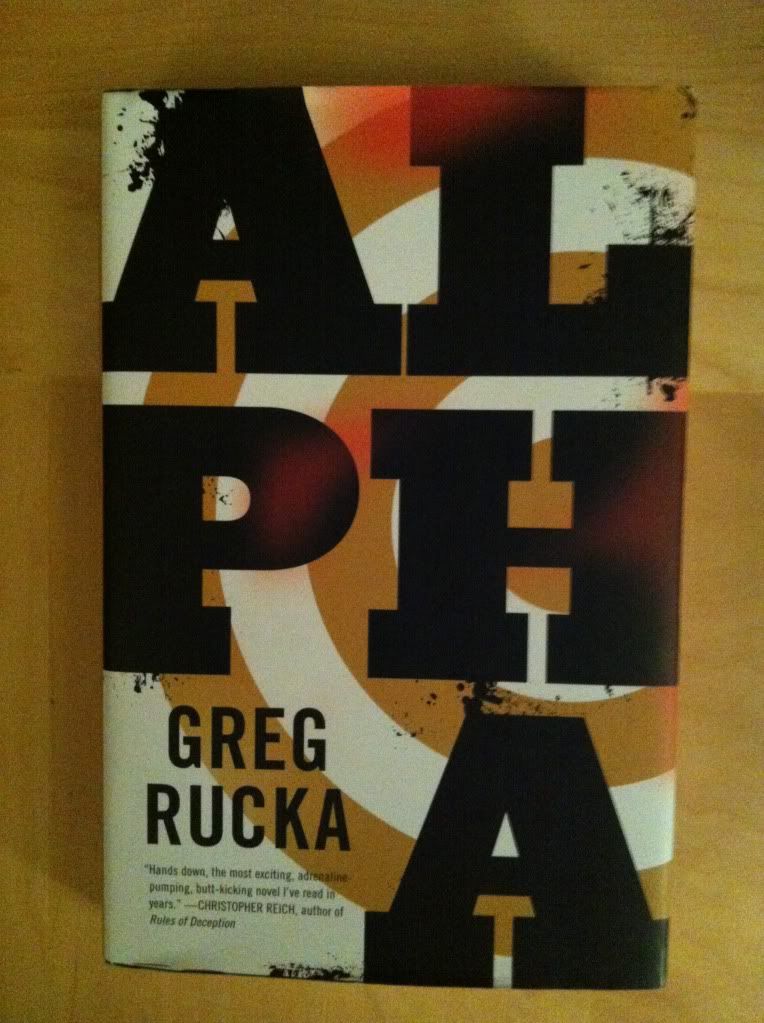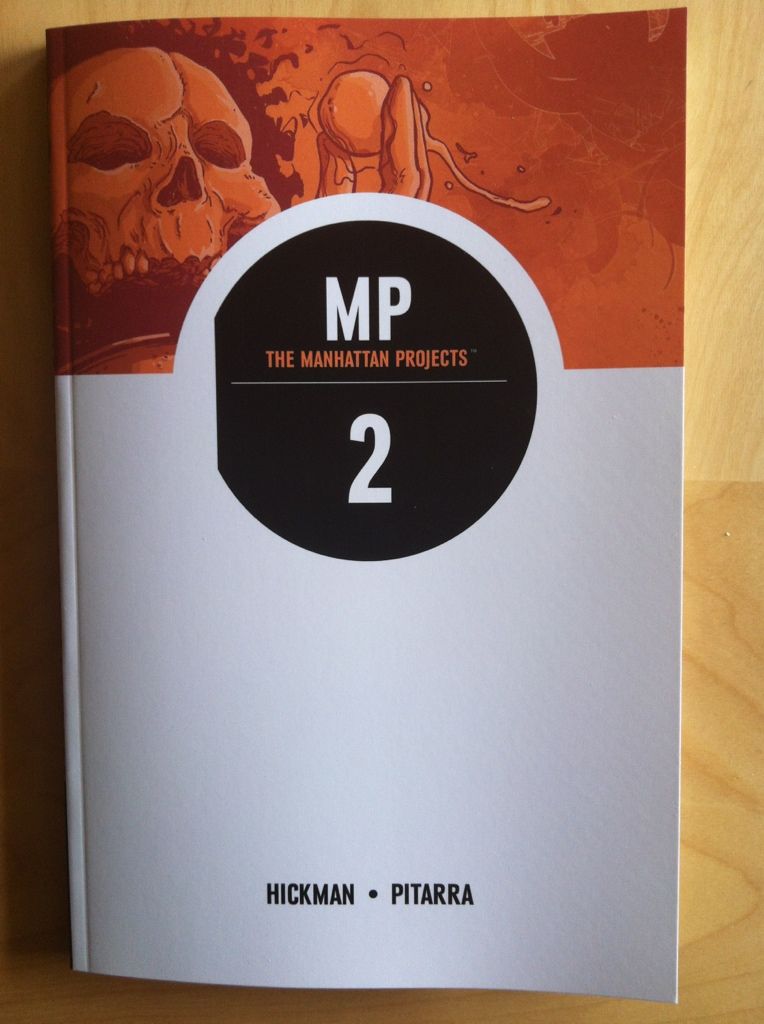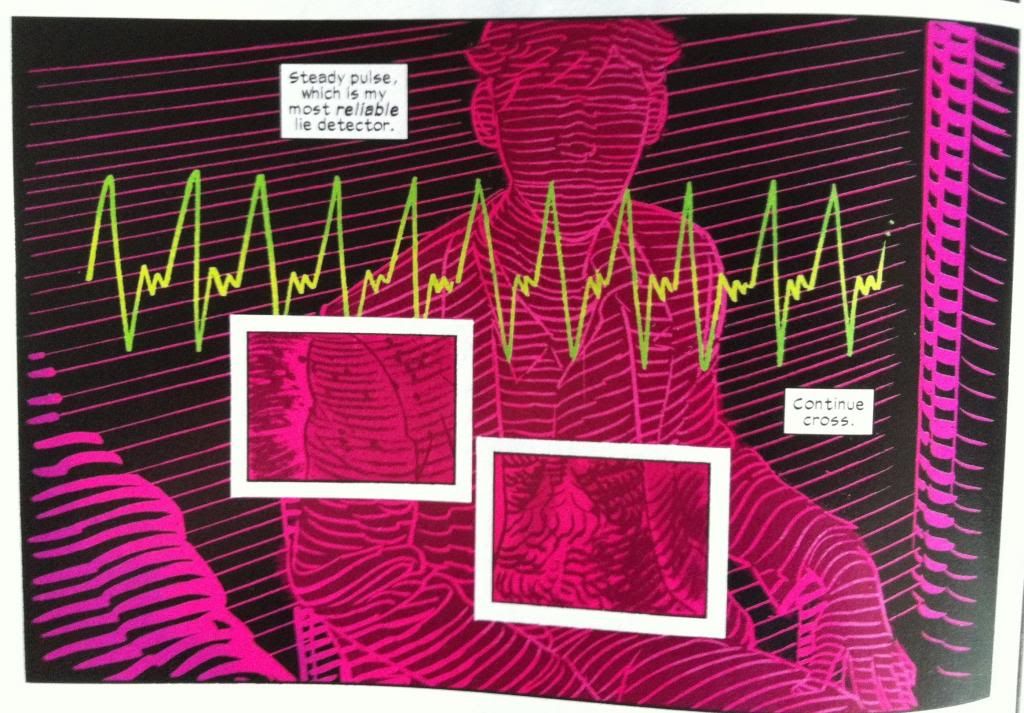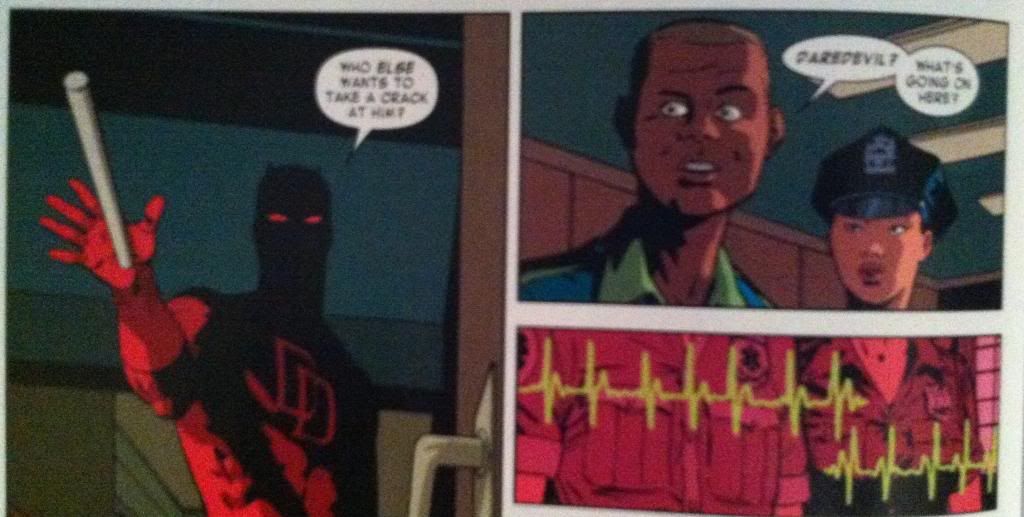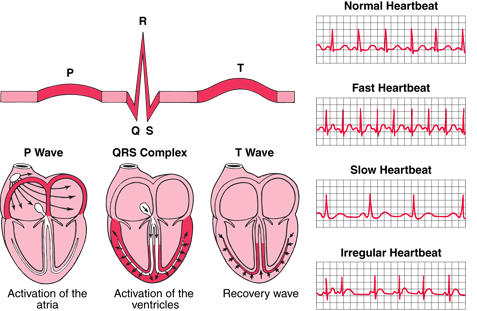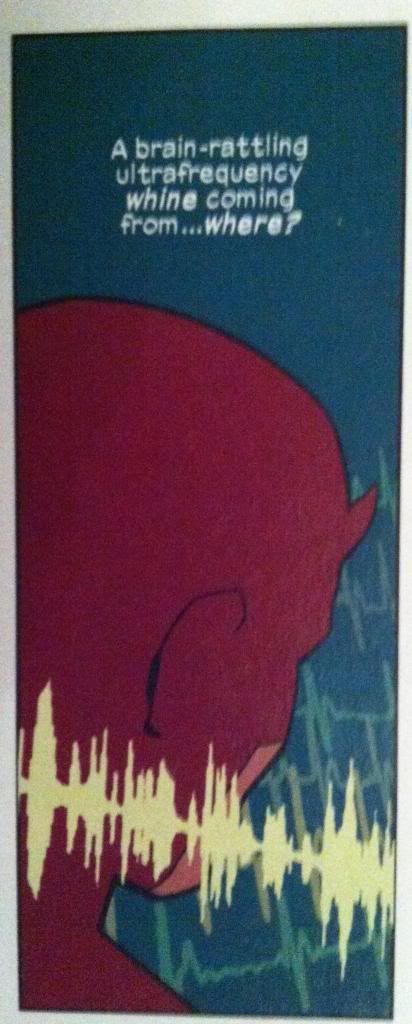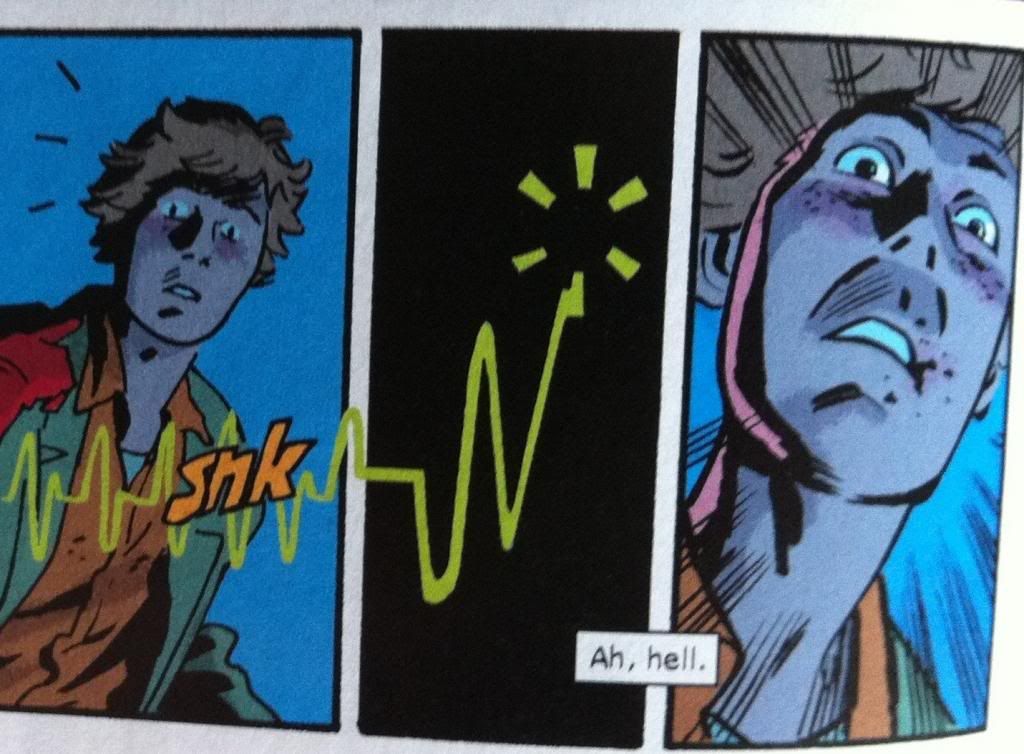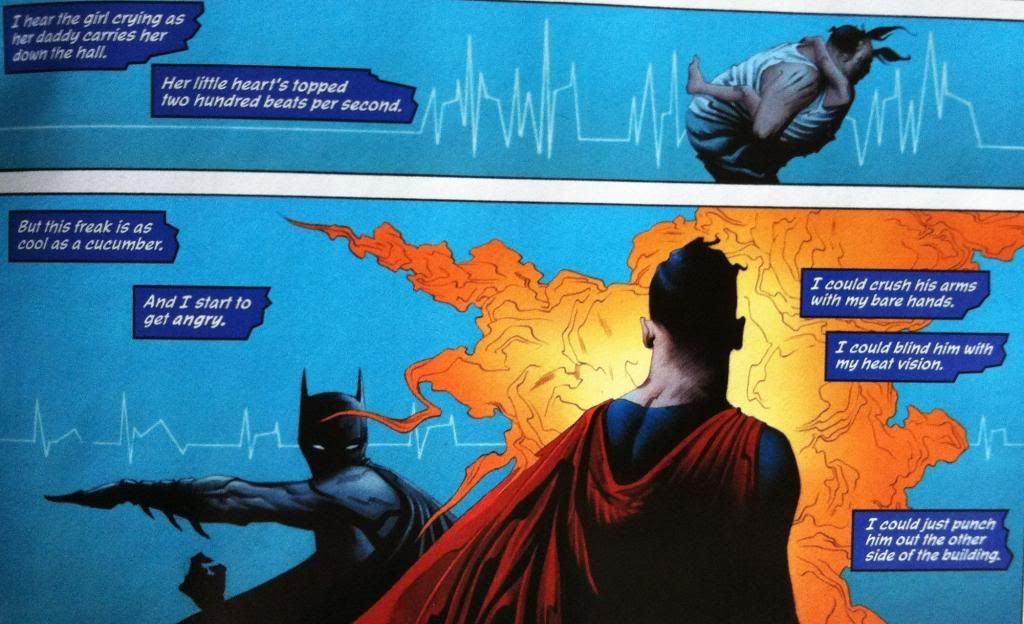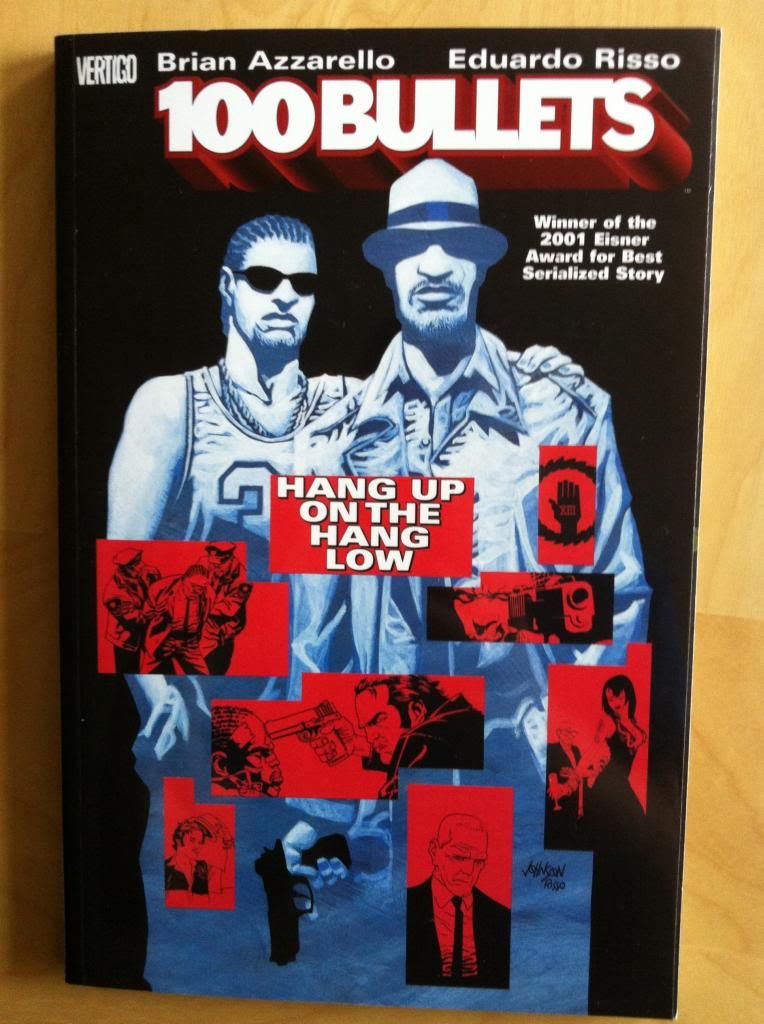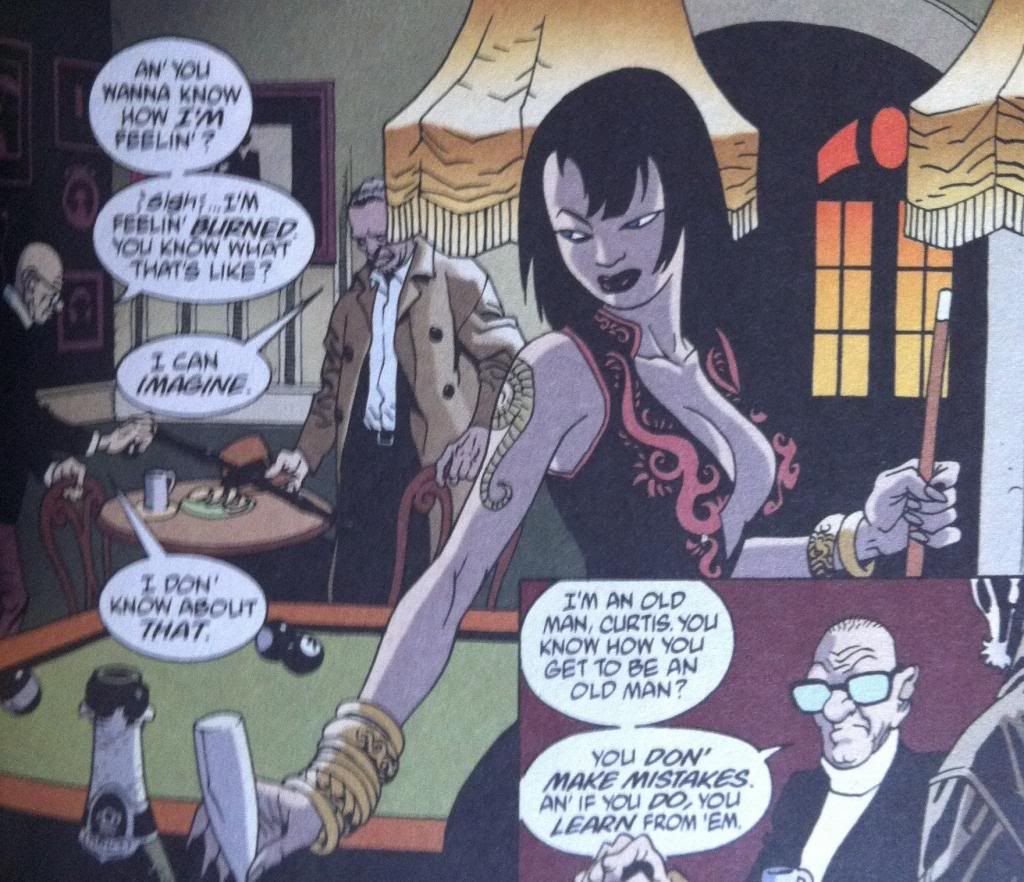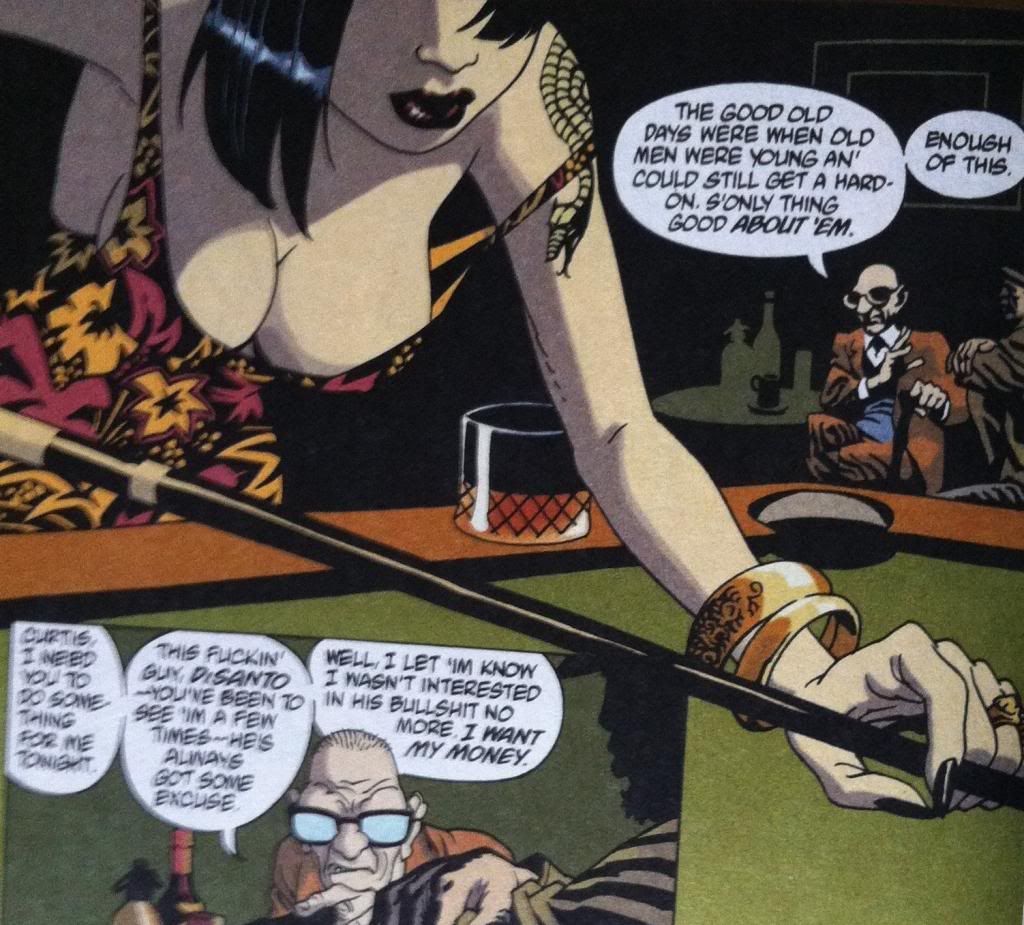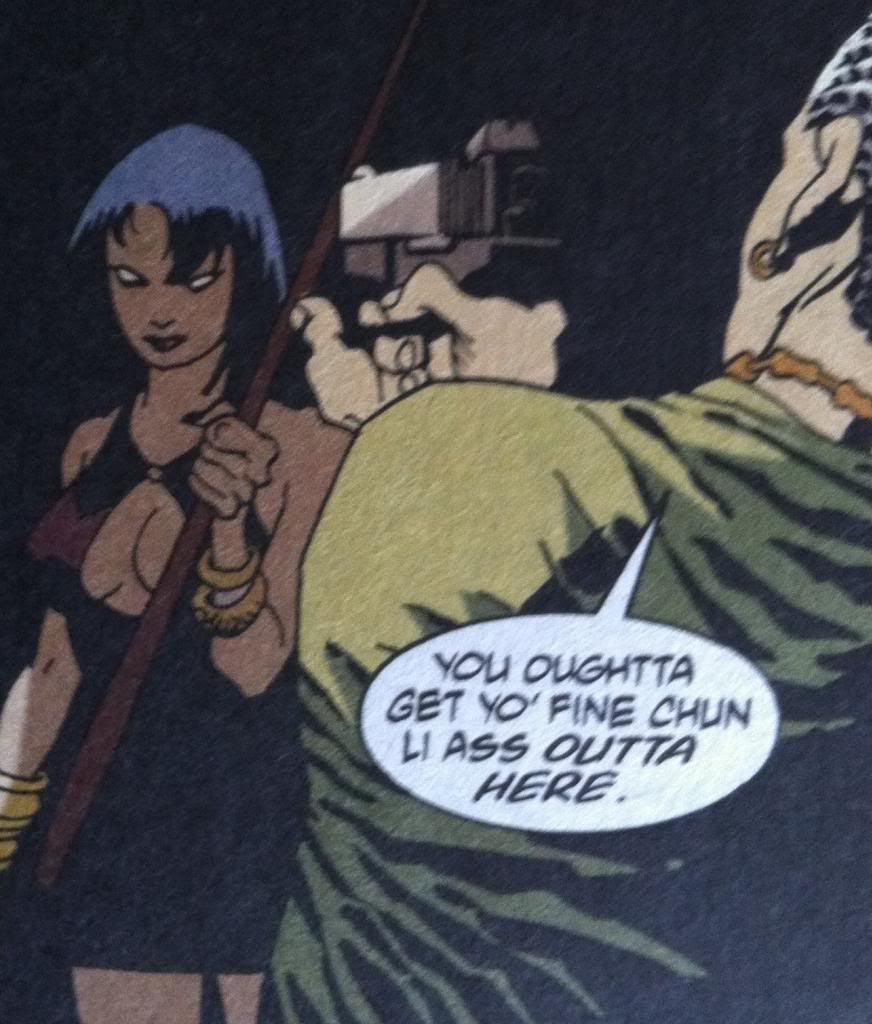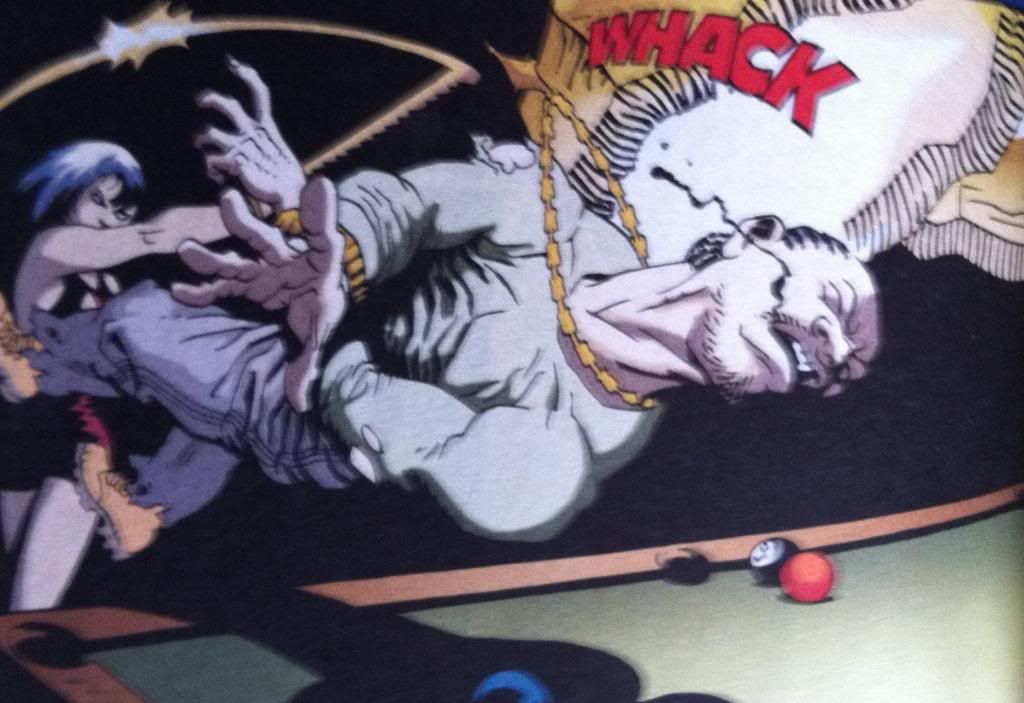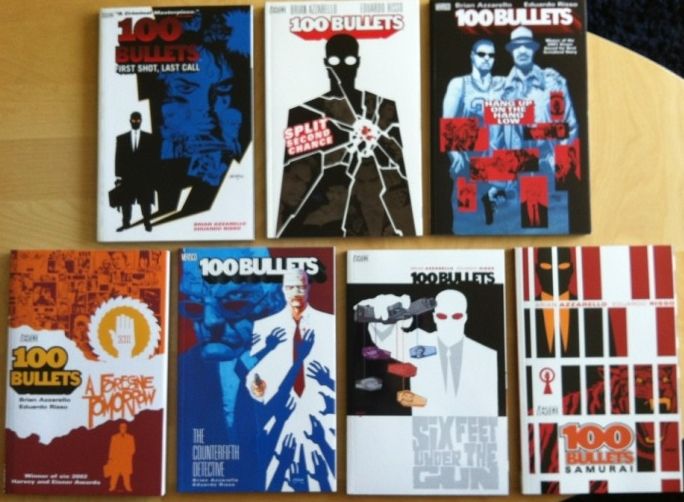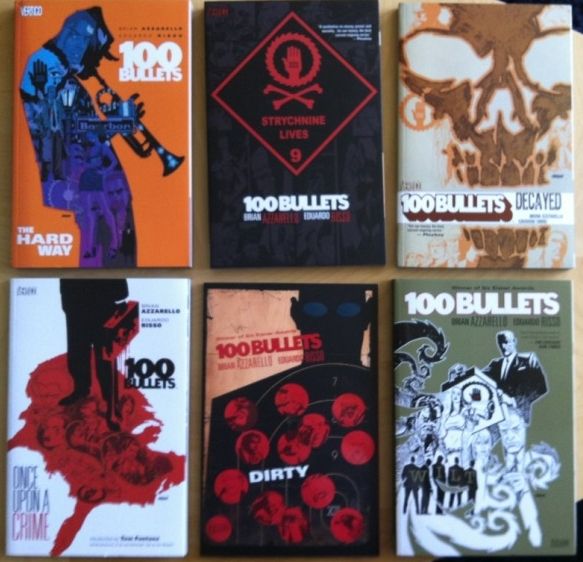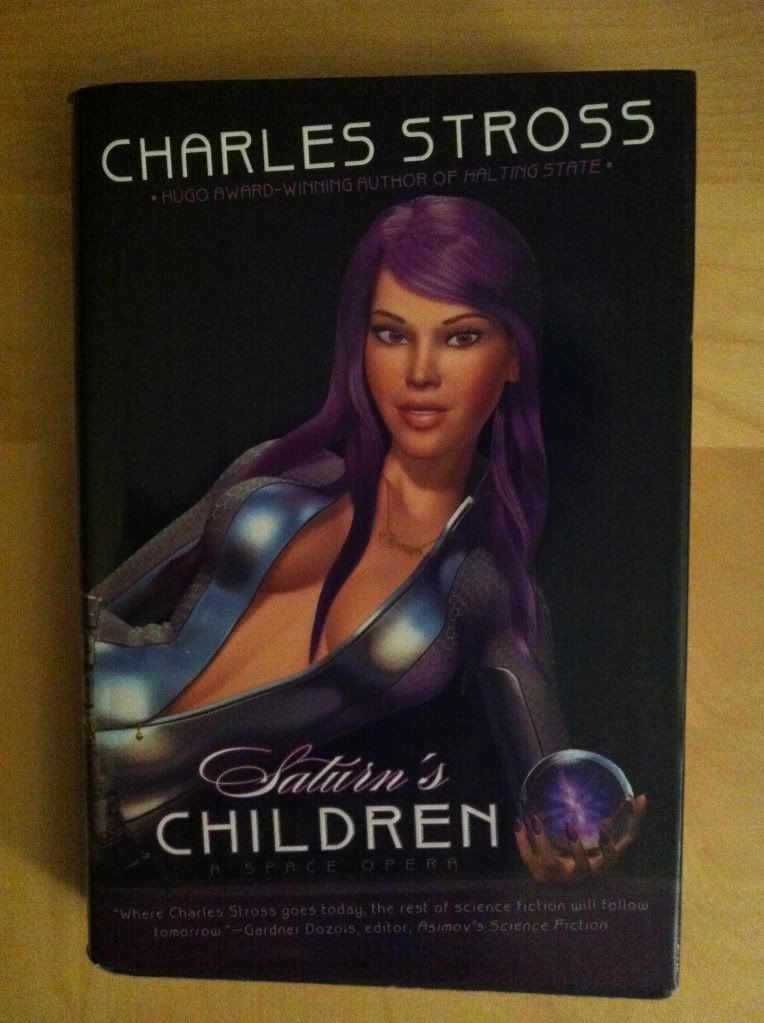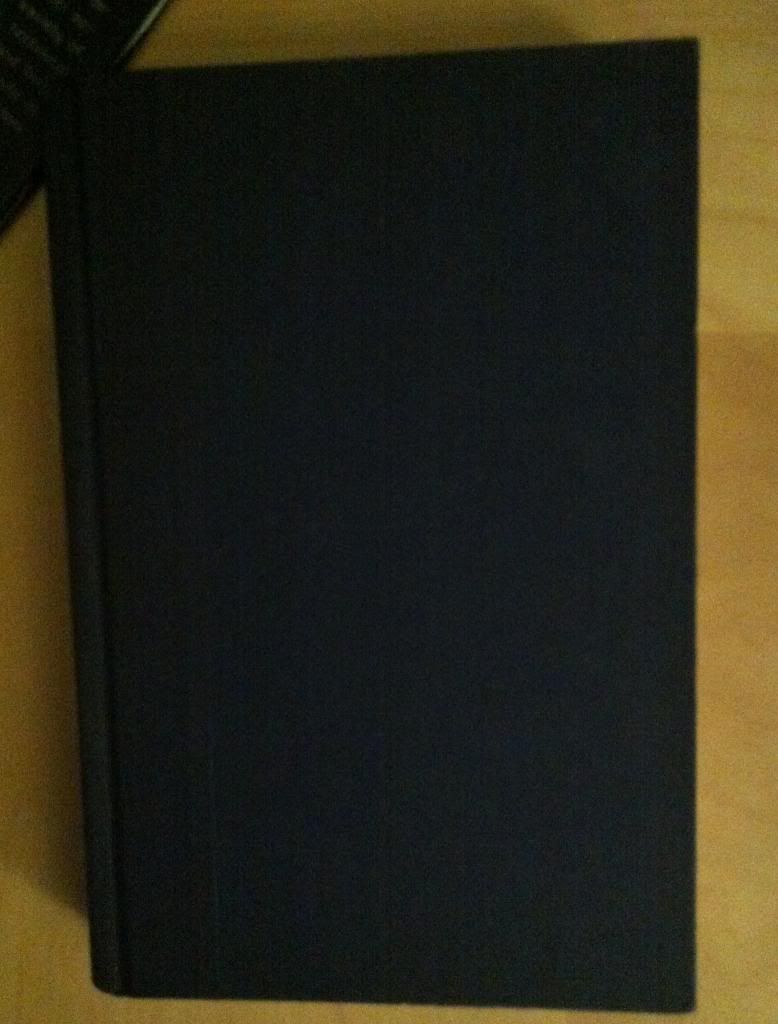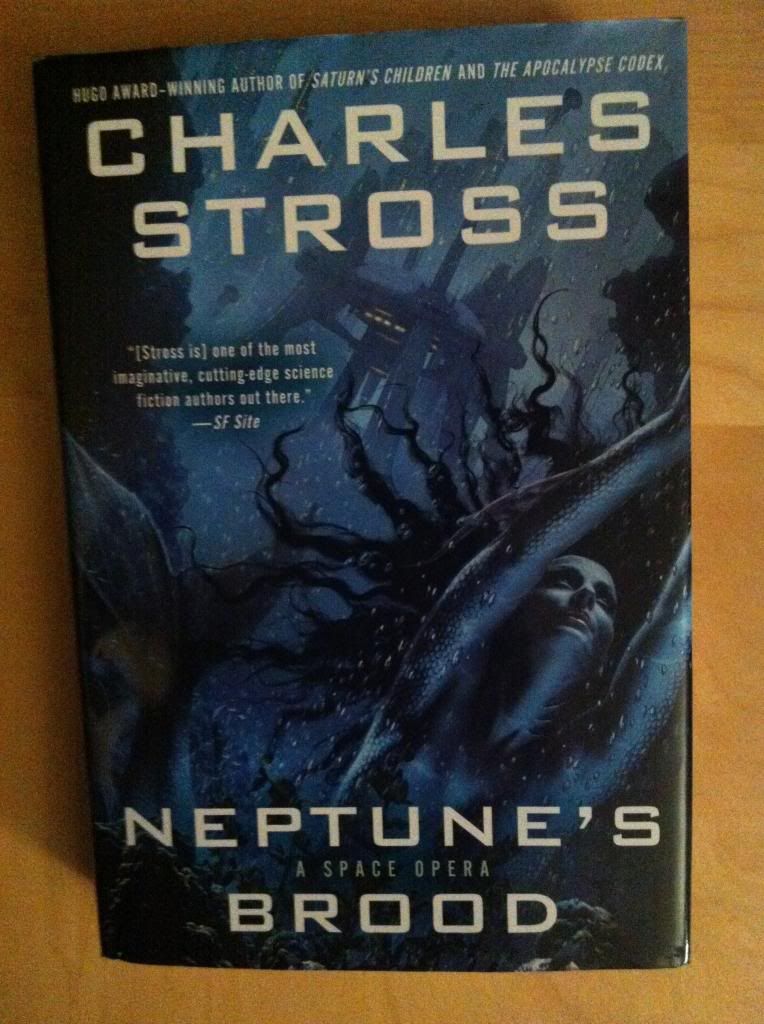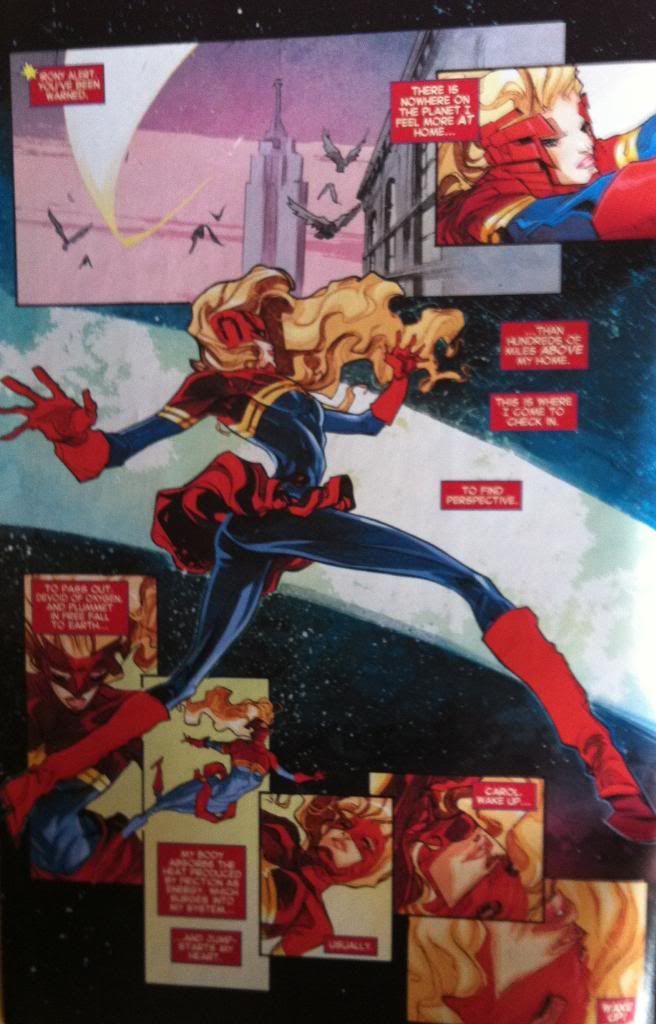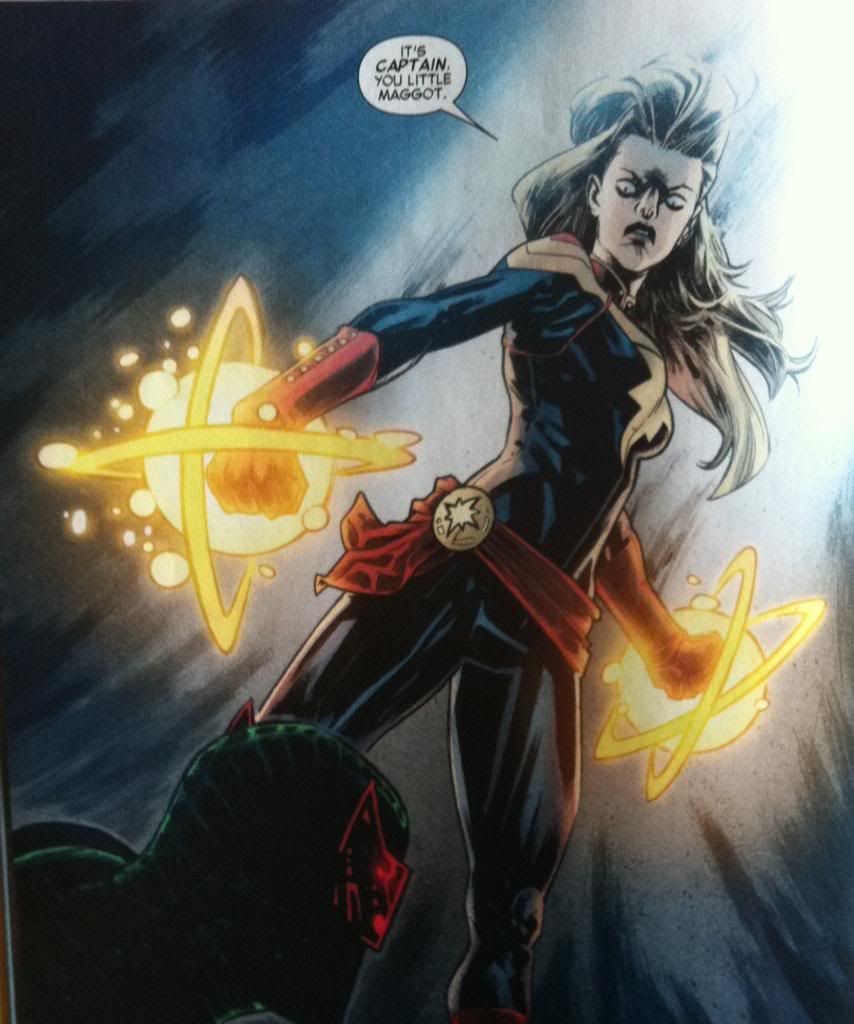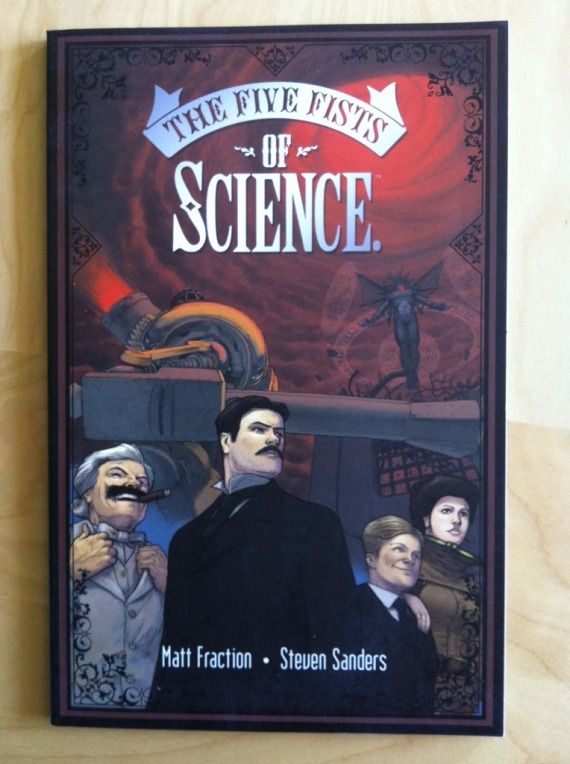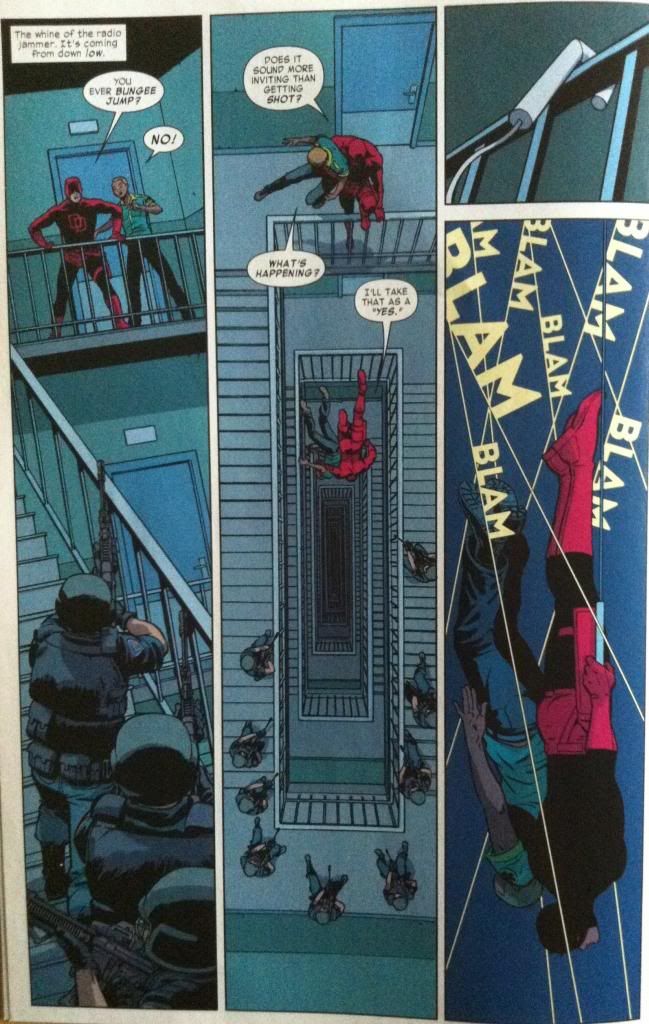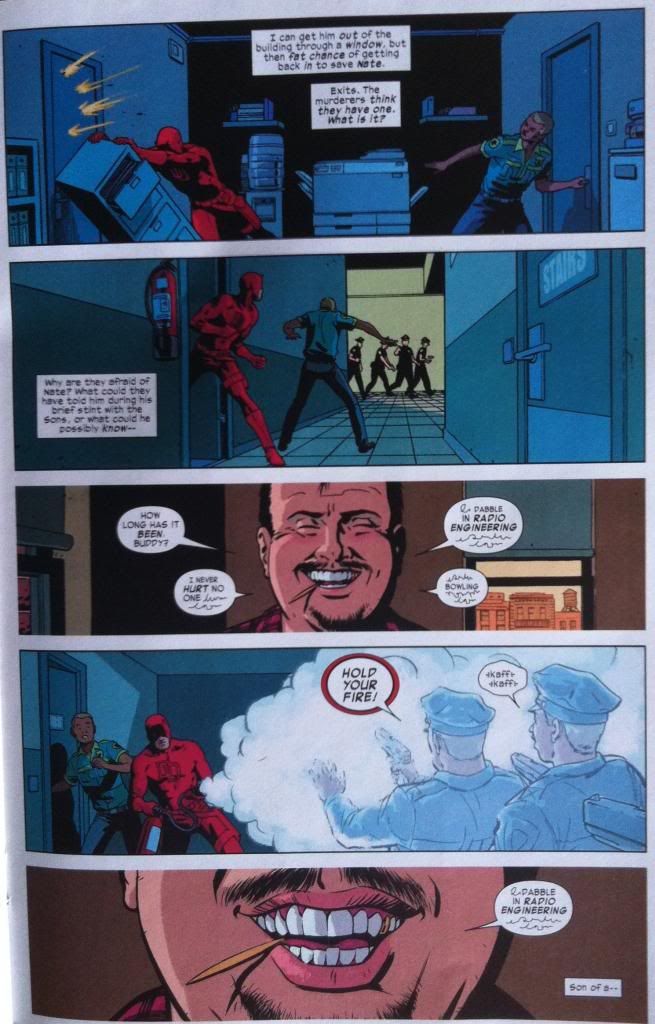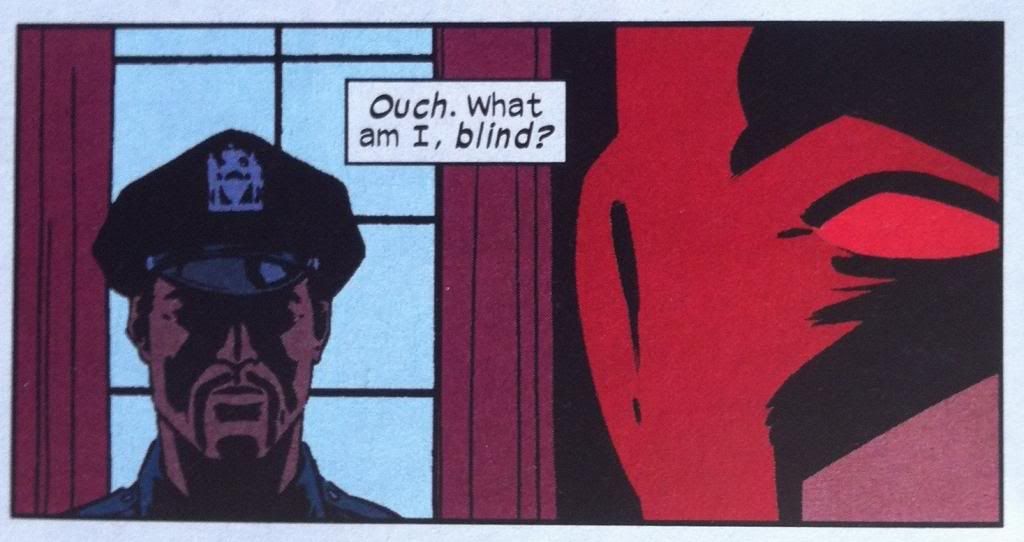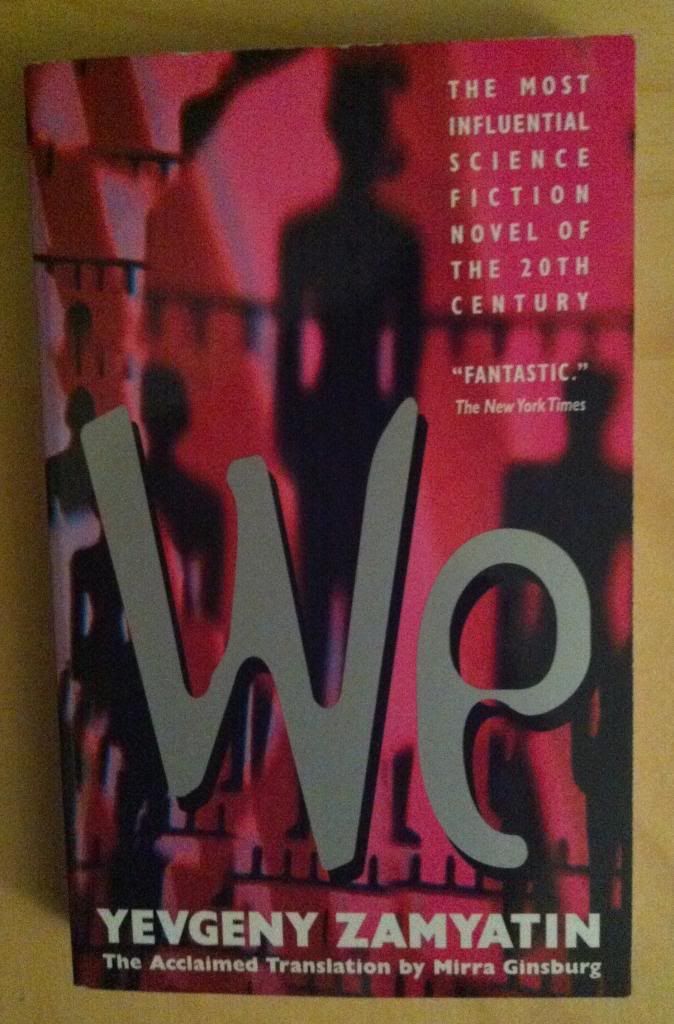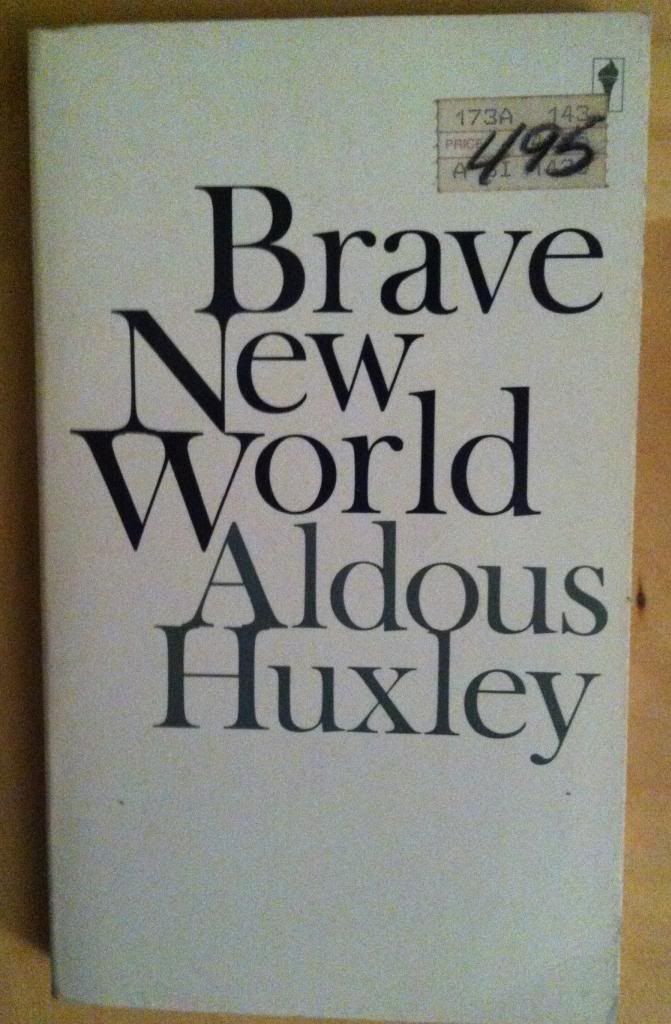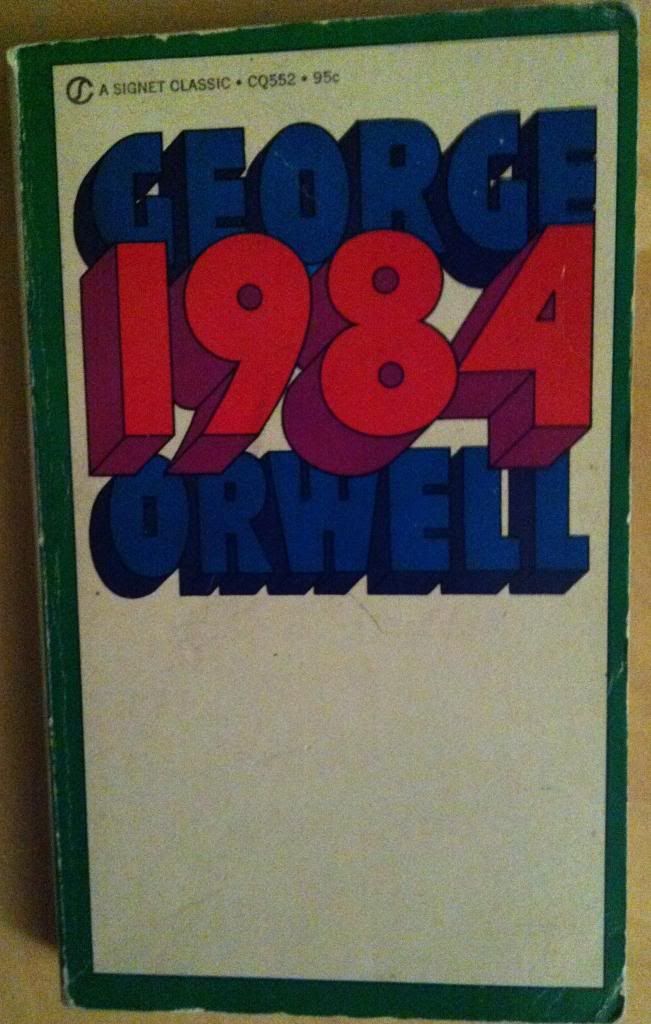Or why you should read Alpha by Greg Rucka
What would the prototypical modern thriller look like? Well it would probably feature a plot by Russian criminals or Islamic Fundamentalist Terrorists attacking some beloved American landmark with some kind of chemical, biological, or radiological weapon. Opposing these forces will be some kind of secret agent or special forces guy from some sort of unknown, hypersecret intelligence department. Maybe this protagonist is backed up by a sexy lady from another secret agency? Maybe the protagonist has a family and they are in danger somehow? Maybe the hero and the villain have some sort of past association or violent history? A modern thriller would probably look something like that.
And, it would probably be pretty shitty.
Alpha by Greg Rucka is a prototypical modern thriller. And it is FANTASTIC.
Alpha begins with the murder of a janitor by a park mascot in WillsonVille, an amusement park bearing a remarkable resemblance to a certain Happiest Place On Earth. Except the janitor isn't a janitor and the murderer might be part of a larger plot targeting America's beloved amusement park. To prevent this from happening Jad Bell, a highly trained Special Forces operative, is placed undercover as director of park security. The threat becomes a reality and Jad Bell finds himself in the midst of a terrorist incident in a crowded amusement park. An incident that promises to get much worse very quickly.
In many ways Alpha is a meta-thriller. It takes the the tropes common to the genre and crafts a story that, at least in the basic form of the plot, follows the common formula. But then you get to the details and the novel transcends its premise and revels itself to be this taught, smart, emotionally affecting novel. Rucka is nothing if not a master craftsmen. The plot of Alpha rockets along, with this meticulously crafted pacing that, like some kind of elaborate mechanical device, systematically ratchets up the tension as events unfold. Alpha is very much a rollercoaster worthy of the WillsonVille amusement park. But it is also a brilliant character study: Jad Bell, beyond being a likeable character, is a vehicle to explore the alienation and social cost modern soldiers experience, and the main villain of the novel provides this incredible glimpse into a person in his situation. And WillsonVille provides this great perspective into how Disneyland works: from the property licensing to the performers to the incredible behind-the-scenes logistics. I say this a person with zero interest in actually visiting Disney amusement parks (and whose partner may want to reproduce purely to draft tiny soldiers in her campaign to make me), but the mechanics of Disneyland are fascinating. And then there are these just amazing little snippets of beautifully crafted and insightful prose sprinkled throughout. Rucka's writing is always great, but Alpha has these miniature discursions that just beg to be appreciated. Alpha is so much more than a by-the-numbers Thriller novel, even if it superficially resembles one.
I recommend this book to anyone looking for something that will sink its teeth into you. This is the kind of book that destroys time, that drags you in and holds your attention until you are done. It is the perfect airplane or commuter or vacation book. It is also a really smart, well written thriller that shows what can be done with the genre. If you are looking for a meta-thriller for smart people I would highly recommend it.
Previously:
Finder, Keeper, and Smoker
Shooting At Midnight
Critical Space, Patriot Acts, Walking Dead
A Fistful of Rain
Queen and Country: A Gentleman's Game, Private Wars, and The Last Run
Friday, 30 August 2013
Wednesday, 28 August 2013
So I Read The Manhattan Projects: Volume 2
A 250 word (or less) review of the second collection of The Manhattan Projects
By Jonathan Hickman, Nick Pitarra, and Jordie Bellaire ; Image Comics
I am a professional Scientist. My research department was founded by an actual member of The Manhattan Project. (Dr. Douglas Harold Copp, look him up.) As such I should be deeply offended by The Manhattan Projects, a comic that implies that the brilliant Scientists of the real life Manhattan Project are a bunch of cannibalistic, murdering, amoral sociopaths performing the Maddest of Sciences. A comic that is deeply insulting to my heroes and my vocation. But, once again, despite myself, I absolutely LOVE this comic. In The Manhattan Projects: Volume 2, the Scientists of The Manhattan Projects encounter their Mad counterparts from the Soviet Union: another secret Science project rife with Nazi prisoner/rocket Scientists, brutalist automatons, squid-aliens from the Tunguska Event, talking Space Dogs, and Communist brains. And instead of fighting the Red Menace, The Manhattan Projects do something ingenious, something that offends the secret cabal of the True world government and leads to a power struggle for the Earth itself. It's more worryingly insane fun from Jonathan Hickman that walks that perfect line of aching sincerity and eyebrow-shrugging fun, which is drawn with the crazy, playful line of Nick Pitarra and coloured with the psychedelic fever hues of Jordie Bellaire. Basically, The Manhattan Projects: Volume 2 is more Bad Science done right. It’s deeply insulting to Scientists, but damn if it isn’t incredible fun.
By Jonathan Hickman, Nick Pitarra, and Jordie Bellaire ; Image Comics
I am a professional Scientist. My research department was founded by an actual member of The Manhattan Project. (Dr. Douglas Harold Copp, look him up.) As such I should be deeply offended by The Manhattan Projects, a comic that implies that the brilliant Scientists of the real life Manhattan Project are a bunch of cannibalistic, murdering, amoral sociopaths performing the Maddest of Sciences. A comic that is deeply insulting to my heroes and my vocation. But, once again, despite myself, I absolutely LOVE this comic. In The Manhattan Projects: Volume 2, the Scientists of The Manhattan Projects encounter their Mad counterparts from the Soviet Union: another secret Science project rife with Nazi prisoner/rocket Scientists, brutalist automatons, squid-aliens from the Tunguska Event, talking Space Dogs, and Communist brains. And instead of fighting the Red Menace, The Manhattan Projects do something ingenious, something that offends the secret cabal of the True world government and leads to a power struggle for the Earth itself. It's more worryingly insane fun from Jonathan Hickman that walks that perfect line of aching sincerity and eyebrow-shrugging fun, which is drawn with the crazy, playful line of Nick Pitarra and coloured with the psychedelic fever hues of Jordie Bellaire. Basically, The Manhattan Projects: Volume 2 is more Bad Science done right. It’s deeply insulting to Scientists, but damn if it isn’t incredible fun.
Word
count: 225
Previously:
Monday, 26 August 2013
Super Science: The Beat That My Heart Skipped
Or representations of heart rate in comics and my crazy pet peeves surrounding them, using examples from Daredevil.
By Mark Waid, Javier Rodrigues, and Chris Samnee; Marvel Comics
A not uncommon trope in comic books is that a character with super hearing can assess the honesty of other characters by listening to their heart beat. The idea is that someone with something to hide will have their heart rate unconsciously increase when they are being untruthful or when they confronted and be betrayed by their telltale heart beat. For characters like Wolverine, Superman, and especially Daredevil, it can be quite common to see our hero confront a potential liar and see the squiggly wave pattern of their heartbeat flash across the panel.
And on the surface this is fine. Liars DO often have an unconscious increase in their heart rate, a response to confrontation that activates their fight-or-flight nerves (Sympathetic Nervous System) which stimulates a faster heart rate. As a result, heart rate is one of the physiological responses that are tracked during a Polygraph lie detector test. This idea actually works to a certain extent in real life. So I really have no issue with the overall concept of using heart rate as an indicator of duplicity in comics.
No my issue is that the sound of a heart beat is portrayed as an electrocardiogram (ECG) waveform.
Now, in my day job, I'm a Science graduate student who studies how heart muscle cells work: specifically how their electrical signalling (which controls contraction and heart rate) influences the rate at which they convert fuel (fat/sugar) to energy (ATP). So I know a bit about how hearts work, and spend more time than an average person looking at and thinking about ECG's. So as a result, I have a crazy person pet peeve about using an ECG waveform as a stand in for the sound of a heart beat. And here's why:
An electrocardiogram measures changes in voltage in the heart. The heart, as you probably know, is an electrically active organ: on a cellular level it moves charged atoms (ions) across cell membranes in such a way to create voltages which in turn turn control heart contraction. During a normal heart beat, a cluster of pacemaker cells, which spontaneously change their voltage, activate themselves by "depolarizing", and start a cascade of electrical signals that will spread around the heart and cause it to contract. Heart cells are joined end to end in a way that lets them carry this electrical signal and activate one another, so once the pacemakers "fire" their activation signal, that signal will eventually travel to every healthy muscle cell in the heart during a single heart beat. And every heart muscle will, when it sees this activation signal, activate and contract, which makes the heart compress and pump blood. Now, the heart has to contract in a coordinated way: different parts of the heart will contract in a sequence, and within those parts thousands of cells have to work all at once. To make this happen the controlling electrical signals in the heart follow a specific, regulated path around the heart. The electrical signal starts in the pacemaking area, travels around the top chambers of the heart (atria), slows down for a tiny moment at a fusey structure to give the atria a chance to contract and empty, and then races down specialized signalling pathways that spread the signal evenly throughout the big lower chambers (ventricles) of the heart so that this part of the heart contracts all at once. What this all means is that if you stick electrodes on opposite sides of the heart you will see regular, repeated patterns in voltage changes, and this pattern is an ECG.
And ECG are awesome tools for measuring heart rate. You get a regular waveform with a small upward tick during atrial depolarization, a complicated down-up-down squiggle during ventricular depolarization, and another upward tick when all the ventricle cells reset themsevles by "repolarizing" (if you measure an ECG in the stereotypical way). You can get all kinds of information from these ECG patterns, including, from how close together or spaced out they are, the heart beat of a person. Which is how they are used in comics.
My crazy-person problem is that voltage changes in the heart have NOTHING to do with how a heart sounds: an ECG is not related to the heart beat sounds at all. And this bothers me a little.
Hearts make a pretty distinctive sound when they beat, a kind of "Lub-Dub" (or, in the words of Johnny from dirty dancing, "Guh-Gung"). This sound is made by the valves in the heart snapping closed during a heartbeat. Heart valves, the doors between the four chambers of the heart and the heart and the rest of the body, function as one way valves that let blood travel one way through the heart and body. So during a heartbeat you get a sound, "LUB", when your ventricle chambers compress, making one pair of valves located between chambers to loudly snap close. Then after the heart stops contracting and relaxes, you get a "DUB" as the other set of valves snap close to stop blood from flowing back into your heart. And this cycle of "Lub-Dubs" directly relates to heart rate and is LITERALLY heart beat. So a slowly beating heart sound something like "Lub-Dub....Lub-Dub...Lub-Dub" while a rapidly beating heart would have a beat like "Lubdub-lubdub-lubdub...". Comic artists could literally just use the onomatopoeia of the sound to make a more realistic portrayal of a racing heart.
But, admittedly that isn't very visually satisfying or efficient comics.
But there is a visual solution that is also accurate. The lub-dub sound is so regular, so characteristic that its waveform, the shape of the sound itself, is so visually distinct that it is a diagnostic tool in medicine. (Literally the first test for heart function, before and ECG or Echocardiogprahy (visuallizing the heart with ultrasound) is a doctor with a stethoscope listening for regular lub-dubs, skipped beats, and weird leaky sounds. And even later in the diagnosis game a more complictaed sound analysis test is sometimes used.) Anyway, this waveform, just like an ECG keeps the same pattern, bigger initial collection of squiggles ("lub") closely followed by smaller cluster of squiggles ("dub"), over and over. Heart rate is defined by how wide the gap between repetitions of the pattern, also just like in an ECG. So really, with the heart sound waveform pattern you get a distinct looking thing that describes heart beat just as well as an ECG waveform that is LITERALLY the sound of the heart beating. So, if an artist wanted to represent the sound of heart rate in a super-detailed and Scientifically correct way they could draw the actual waveform pattern of the heart.
Now, I'm aware how crazy, pedantic, and unfair this pet peeve is. Normal people don't care about the distinction between heart sounds, heart muscle contraction, blood pressure, and electrical activity when measuring heart rate. I suspect for most people an ECG is just as valid a way of representing audible changes in heart rate as my purposed "lub-dub" sound waveform. In fact, from a comics-as-visual-media perspective an ECG is probably a BETTER way of representing heart rate than the sounds: it is much more universally recognized as a heart specific thing and directly relates to heart rate in the human imagination. Hell, it is even tied to sound with the "bleep-bleep-bleep" of heart rate monitors in hospital settings (and the "bleeeeee...." of a stopped heart). The ECG as a symbol conveys much more visual meaning with more efficiency than the Scientifically accurate sound diagram, and since comics are about telling stories in visual ways and not appeasing internet jerks using ECG's is probably the right choice.
The right choice that I find irrationally annoying.
(Oh, and while I am on the topic of ECG's in comic books, I recently tried the first issue of the new Superman/Batman comic by Brain Azzarello and Lee Bermejo, and there is a use of ECG in here that is all kinds of wrong. While trying to portray a racing heart in a terrified man fighting (to contrast it to the cool as cucumbers steady beat of Bruce Wayne) they used a crazy erratic ECG trace. This is how an ECG would look if you were having a SERIOUS ahrrythmic/ventricular fibrillation event. Seriously, this is how an ECG would look if you were DIEING of "Sudden Cardiac Death". A racing heart keeps the pattern's shape: sound and ECG patterns don't change, they just repeat faster. An ECG drawn this way isn't just me-being-a-lame-pedant-wrong, but is meaningfully factually wrong.)
By Mark Waid, Javier Rodrigues, and Chris Samnee; Marvel Comics
A not uncommon trope in comic books is that a character with super hearing can assess the honesty of other characters by listening to their heart beat. The idea is that someone with something to hide will have their heart rate unconsciously increase when they are being untruthful or when they confronted and be betrayed by their telltale heart beat. For characters like Wolverine, Superman, and especially Daredevil, it can be quite common to see our hero confront a potential liar and see the squiggly wave pattern of their heartbeat flash across the panel.
And on the surface this is fine. Liars DO often have an unconscious increase in their heart rate, a response to confrontation that activates their fight-or-flight nerves (Sympathetic Nervous System) which stimulates a faster heart rate. As a result, heart rate is one of the physiological responses that are tracked during a Polygraph lie detector test. This idea actually works to a certain extent in real life. So I really have no issue with the overall concept of using heart rate as an indicator of duplicity in comics.
No my issue is that the sound of a heart beat is portrayed as an electrocardiogram (ECG) waveform.
Now, in my day job, I'm a Science graduate student who studies how heart muscle cells work: specifically how their electrical signalling (which controls contraction and heart rate) influences the rate at which they convert fuel (fat/sugar) to energy (ATP). So I know a bit about how hearts work, and spend more time than an average person looking at and thinking about ECG's. So as a result, I have a crazy person pet peeve about using an ECG waveform as a stand in for the sound of a heart beat. And here's why:
An electrocardiogram measures changes in voltage in the heart. The heart, as you probably know, is an electrically active organ: on a cellular level it moves charged atoms (ions) across cell membranes in such a way to create voltages which in turn turn control heart contraction. During a normal heart beat, a cluster of pacemaker cells, which spontaneously change their voltage, activate themselves by "depolarizing", and start a cascade of electrical signals that will spread around the heart and cause it to contract. Heart cells are joined end to end in a way that lets them carry this electrical signal and activate one another, so once the pacemakers "fire" their activation signal, that signal will eventually travel to every healthy muscle cell in the heart during a single heart beat. And every heart muscle will, when it sees this activation signal, activate and contract, which makes the heart compress and pump blood. Now, the heart has to contract in a coordinated way: different parts of the heart will contract in a sequence, and within those parts thousands of cells have to work all at once. To make this happen the controlling electrical signals in the heart follow a specific, regulated path around the heart. The electrical signal starts in the pacemaking area, travels around the top chambers of the heart (atria), slows down for a tiny moment at a fusey structure to give the atria a chance to contract and empty, and then races down specialized signalling pathways that spread the signal evenly throughout the big lower chambers (ventricles) of the heart so that this part of the heart contracts all at once. What this all means is that if you stick electrodes on opposite sides of the heart you will see regular, repeated patterns in voltage changes, and this pattern is an ECG.
And ECG are awesome tools for measuring heart rate. You get a regular waveform with a small upward tick during atrial depolarization, a complicated down-up-down squiggle during ventricular depolarization, and another upward tick when all the ventricle cells reset themsevles by "repolarizing" (if you measure an ECG in the stereotypical way). You can get all kinds of information from these ECG patterns, including, from how close together or spaced out they are, the heart beat of a person. Which is how they are used in comics.
My crazy-person problem is that voltage changes in the heart have NOTHING to do with how a heart sounds: an ECG is not related to the heart beat sounds at all. And this bothers me a little.
Hearts make a pretty distinctive sound when they beat, a kind of "Lub-Dub" (or, in the words of Johnny from dirty dancing, "Guh-Gung"). This sound is made by the valves in the heart snapping closed during a heartbeat. Heart valves, the doors between the four chambers of the heart and the heart and the rest of the body, function as one way valves that let blood travel one way through the heart and body. So during a heartbeat you get a sound, "LUB", when your ventricle chambers compress, making one pair of valves located between chambers to loudly snap close. Then after the heart stops contracting and relaxes, you get a "DUB" as the other set of valves snap close to stop blood from flowing back into your heart. And this cycle of "Lub-Dubs" directly relates to heart rate and is LITERALLY heart beat. So a slowly beating heart sound something like "Lub-Dub....Lub-Dub...Lub-Dub" while a rapidly beating heart would have a beat like "Lubdub-lubdub-lubdub...". Comic artists could literally just use the onomatopoeia of the sound to make a more realistic portrayal of a racing heart.
But, admittedly that isn't very visually satisfying or efficient comics.
But there is a visual solution that is also accurate. The lub-dub sound is so regular, so characteristic that its waveform, the shape of the sound itself, is so visually distinct that it is a diagnostic tool in medicine. (Literally the first test for heart function, before and ECG or Echocardiogprahy (visuallizing the heart with ultrasound) is a doctor with a stethoscope listening for regular lub-dubs, skipped beats, and weird leaky sounds. And even later in the diagnosis game a more complictaed sound analysis test is sometimes used.) Anyway, this waveform, just like an ECG keeps the same pattern, bigger initial collection of squiggles ("lub") closely followed by smaller cluster of squiggles ("dub"), over and over. Heart rate is defined by how wide the gap between repetitions of the pattern, also just like in an ECG. So really, with the heart sound waveform pattern you get a distinct looking thing that describes heart beat just as well as an ECG waveform that is LITERALLY the sound of the heart beating. So, if an artist wanted to represent the sound of heart rate in a super-detailed and Scientifically correct way they could draw the actual waveform pattern of the heart.
Now, I'm aware how crazy, pedantic, and unfair this pet peeve is. Normal people don't care about the distinction between heart sounds, heart muscle contraction, blood pressure, and electrical activity when measuring heart rate. I suspect for most people an ECG is just as valid a way of representing audible changes in heart rate as my purposed "lub-dub" sound waveform. In fact, from a comics-as-visual-media perspective an ECG is probably a BETTER way of representing heart rate than the sounds: it is much more universally recognized as a heart specific thing and directly relates to heart rate in the human imagination. Hell, it is even tied to sound with the "bleep-bleep-bleep" of heart rate monitors in hospital settings (and the "bleeeeee...." of a stopped heart). The ECG as a symbol conveys much more visual meaning with more efficiency than the Scientifically accurate sound diagram, and since comics are about telling stories in visual ways and not appeasing internet jerks using ECG's is probably the right choice.
The right choice that I find irrationally annoying.
(Oh, and while I am on the topic of ECG's in comic books, I recently tried the first issue of the new Superman/Batman comic by Brain Azzarello and Lee Bermejo, and there is a use of ECG in here that is all kinds of wrong. While trying to portray a racing heart in a terrified man fighting (to contrast it to the cool as cucumbers steady beat of Bruce Wayne) they used a crazy erratic ECG trace. This is how an ECG would look if you were having a SERIOUS ahrrythmic/ventricular fibrillation event. Seriously, this is how an ECG would look if you were DIEING of "Sudden Cardiac Death". A racing heart keeps the pattern's shape: sound and ECG patterns don't change, they just repeat faster. An ECG drawn this way isn't just me-being-a-lame-pedant-wrong, but is meaningfully factually wrong.)
Friday, 23 August 2013
Deep Sequencing: The Male Gaze In 100 Bullets: Hang Up On The Hang Low
Or the self-aware use of sexualized imagery to service story in 100 Bullets: Volume 3.
By Brian Azzarello and Eduardo Risso; Vertigo Comics
100 Bullets is a pretty ugly comic. I mean, it's exquisitely drawn by Edurardo Risso, but the comic is full of terrible people doing godawful things in horrifying ways. Despite how entertaining and smart it is, 100 Bullets is a WILDLY problematic comic in a LOT of ways.
One of the more striking ways 100 Bullets is problematic is in its portrayal of women. They really get the shittiest end of the shitstick and have all kinds of dramatically terrible things happen to them. They are also portrayed in a VERY sexual, very objectified way. Eduardo Risso is a master of the male gaze: drawing attractive women with fantasy proportions and then framing panels to highlight the bejesus out of them. It's complicated and problematic and skeevy and sometimes hard to reconcile with the story. I mean, I think the over-sexualizing of women in the comic is about deliberately creating a certain transgressive atmosphere of hyper-violence and hyper-sexuality... But maybe Eduardo Risso just likes to draw beautiful, fantasy women in dangerous situations? Regardless, it's a facet of the series, and it's one that I have a hard time reconciling myself with or really understanding completely within the context of the comic. It is not my favourite part of 100 Bullets.
However, there is one chapter of 100 Bullets where the male-gaze objectification of a female character is used in this really self-aware way and in service to the story. This is in the third collected chapter: Hang Up On The Hang Low.
This post will deal with extensive *SPOILERS* to this chapter of the comic. So read it first.
In this section of the story Agent Graves, the shadowy purveyor of Revenge, gives Loop, a young black man, a clean gun, 100 untraceable bullets, protection from law enforcement, and information as to where he can find his deadbeat father. Loop tracks down his father, an enforcer for a local crime boss, and rather than kill his dad, he joins him in the family business. Unfortunately things go sideways, Loop's father is murdered, and Loop decides to kill the crime boss responsible. It's a neat character study, revenge scenario, and like all of 100 Bullets, arresting comics.
One of the cooler aspects of this comic is how the male gaze, using image framing to show off sexy body parts, is used to sexualize the asian woman playing pool. I mean the first time you see her, based on her dress, how the comic frames her, and the context of the situation, you make some assumptions. I mean, this young woman is wearing provocative clothing, playing pool alone in a room with a little old man who is a crime boss and within the context of the story holds all the power. Moreover, the comic artwork focuses on her breasts and places her in the background, disinterested and silent, like, to borrow a DeConnick-ism, a sexy lamp who really likes Billiards. So we all assume that she is most likely there to be eye-candy for the creepy crime boss, or a sexual plaything, or something equally fucking deplorable and exploitative.
Which makes it so amazing and surprising when she turns out to be a bodyguard. We, and Loop, and make the assumption she is a sexy lamp, and then BAM we find out she is really a stonecold shitkicking motherfucker. This comic has used the male gaze to cause us to make assumptions based on gender roles and appearance which leads us to underestimate this character and disguise her true role in the story. And this is pretty self-aware and effective use of the male-gaze to actually drive a story instead of just glorify in smut, and it makes the point that we should check our assumptions when it comes to sexuality and gender. It's cool comics.
I mean, there is still a lot of problematic male gaze use in 100 Bullets, but this particular example, I think, is pretty great. (But you know, still problematic, which is pretty much how all of 100 Bullets works.)
Previously:
Deep Sequencing: Guilt and Crime Comics
By Brian Azzarello and Eduardo Risso; Vertigo Comics
100 Bullets is a pretty ugly comic. I mean, it's exquisitely drawn by Edurardo Risso, but the comic is full of terrible people doing godawful things in horrifying ways. Despite how entertaining and smart it is, 100 Bullets is a WILDLY problematic comic in a LOT of ways.
One of the more striking ways 100 Bullets is problematic is in its portrayal of women. They really get the shittiest end of the shitstick and have all kinds of dramatically terrible things happen to them. They are also portrayed in a VERY sexual, very objectified way. Eduardo Risso is a master of the male gaze: drawing attractive women with fantasy proportions and then framing panels to highlight the bejesus out of them. It's complicated and problematic and skeevy and sometimes hard to reconcile with the story. I mean, I think the over-sexualizing of women in the comic is about deliberately creating a certain transgressive atmosphere of hyper-violence and hyper-sexuality... But maybe Eduardo Risso just likes to draw beautiful, fantasy women in dangerous situations? Regardless, it's a facet of the series, and it's one that I have a hard time reconciling myself with or really understanding completely within the context of the comic. It is not my favourite part of 100 Bullets.
However, there is one chapter of 100 Bullets where the male-gaze objectification of a female character is used in this really self-aware way and in service to the story. This is in the third collected chapter: Hang Up On The Hang Low.
This post will deal with extensive *SPOILERS* to this chapter of the comic. So read it first.
In this section of the story Agent Graves, the shadowy purveyor of Revenge, gives Loop, a young black man, a clean gun, 100 untraceable bullets, protection from law enforcement, and information as to where he can find his deadbeat father. Loop tracks down his father, an enforcer for a local crime boss, and rather than kill his dad, he joins him in the family business. Unfortunately things go sideways, Loop's father is murdered, and Loop decides to kill the crime boss responsible. It's a neat character study, revenge scenario, and like all of 100 Bullets, arresting comics.
One of the cooler aspects of this comic is how the male gaze, using image framing to show off sexy body parts, is used to sexualize the asian woman playing pool. I mean the first time you see her, based on her dress, how the comic frames her, and the context of the situation, you make some assumptions. I mean, this young woman is wearing provocative clothing, playing pool alone in a room with a little old man who is a crime boss and within the context of the story holds all the power. Moreover, the comic artwork focuses on her breasts and places her in the background, disinterested and silent, like, to borrow a DeConnick-ism, a sexy lamp who really likes Billiards. So we all assume that she is most likely there to be eye-candy for the creepy crime boss, or a sexual plaything, or something equally fucking deplorable and exploitative.
Which makes it so amazing and surprising when she turns out to be a bodyguard. We, and Loop, and make the assumption she is a sexy lamp, and then BAM we find out she is really a stonecold shitkicking motherfucker. This comic has used the male gaze to cause us to make assumptions based on gender roles and appearance which leads us to underestimate this character and disguise her true role in the story. And this is pretty self-aware and effective use of the male-gaze to actually drive a story instead of just glorify in smut, and it makes the point that we should check our assumptions when it comes to sexuality and gender. It's cool comics.
I mean, there is still a lot of problematic male gaze use in 100 Bullets, but this particular example, I think, is pretty great. (But you know, still problematic, which is pretty much how all of 100 Bullets works.)
Previously:
Deep Sequencing: Guilt and Crime Comics
Wednesday, 21 August 2013
So I Read 100 Bullets
A 250 word (or less) review of 100 Bullets, the complete series
By Brian Azzarello and Eduardo Risso, Vertigo Comics
What would you do with the perfect opportunity for revenge? 100 Bullets, in its earliest chapters, asks just that question when the mysterious Agent Graves gives characters lurking on the edges of society a briefcase containing a clean handgun, 100 bullets of untraceable ammunition, incontrovertible proof of a perpetrators guilt, and the promise of no repercussions. From these grisly, intense moral experiments, 100 Bullets grows into an immense and convoluted crime epic about the power of the shadowy Trust, broken by greed and ambition and guilt, and the horribly flawed enforcers whose job is to referee it. In many ways 100 Bullets is a comic of flaws: horrendously, glorious flawed characters performing flawed and reprehensible acts, for reasons that are equally disgusting and flawed. It is an absolutely brutal read, that, I think contains within it, amongst the shock and violence, some truly remarkable and sublime moments. Brian Azzarello delivers an unrelenting script that never shies from going to the most uncomfortable and tragic places; it is a brave and audacious story. Eduardo Risso, meanwhile, is a goddamn genius. His artwork, this minimalistic cartoon line, has such beauty and elegance of composition to it, and yet, renders such brutality and evil with such ease. It is worth the price of admission alone. That said, 100 Bullets does have some flaws itself: some creative decisions treat groups of characters, particularly women, in spectacularly shitty ways that are wildly problematic. 100 Bullets is a gloriously, horribly flawed comic that you should read.
Word count: 250
By Brian Azzarello and Eduardo Risso, Vertigo Comics
What would you do with the perfect opportunity for revenge? 100 Bullets, in its earliest chapters, asks just that question when the mysterious Agent Graves gives characters lurking on the edges of society a briefcase containing a clean handgun, 100 bullets of untraceable ammunition, incontrovertible proof of a perpetrators guilt, and the promise of no repercussions. From these grisly, intense moral experiments, 100 Bullets grows into an immense and convoluted crime epic about the power of the shadowy Trust, broken by greed and ambition and guilt, and the horribly flawed enforcers whose job is to referee it. In many ways 100 Bullets is a comic of flaws: horrendously, glorious flawed characters performing flawed and reprehensible acts, for reasons that are equally disgusting and flawed. It is an absolutely brutal read, that, I think contains within it, amongst the shock and violence, some truly remarkable and sublime moments. Brian Azzarello delivers an unrelenting script that never shies from going to the most uncomfortable and tragic places; it is a brave and audacious story. Eduardo Risso, meanwhile, is a goddamn genius. His artwork, this minimalistic cartoon line, has such beauty and elegance of composition to it, and yet, renders such brutality and evil with such ease. It is worth the price of admission alone. That said, 100 Bullets does have some flaws itself: some creative decisions treat groups of characters, particularly women, in spectacularly shitty ways that are wildly problematic. 100 Bullets is a gloriously, horribly flawed comic that you should read.
Word count: 250
Monday, 19 August 2013
Saturn's Children and Neptune's Brood Are Good Books
Or why you should read Saturn's Children and Neptune's Brood, by Charles Stross
One of my favourite aspects of Science Fiction is that, beyond being entertaining stories, it is all about speculation. It is a genre where cracking-smart, imaginative people get to take concepts and technologies and philosophies and create elaborate scenarios to experiment with them. Where we get to enter a discourse about surveillance societies, or anchorable wormholes, or immortality, or styles of government, or robotic servants and see how an author thinks they will affect our lives. I mean, good Science Fiction is still entertaining, but many of the best examples are also interesting and informative.
Saturn's Children and Neptune's Brood are two works of thought experiment Science Fiction.
Saturn's Children: Is a novel about a Sex Robot...
No wait! It's really good and mature and not what you think!
Let's start over...
(That's much better, isn't it? First time I was grateful for the removableness of a dust cover...)
Saturn's Children: is a novel about a Sex Robot and she, Freya Nakamichi-47, is the PERFECT protagonist for the novel. Saturn's Children is a thought experiment about the ethics of creating feeling, sentient robotic servants.
The first key idea is that Robots (and really all technology) are designed in relation to human beings, even though our technological artifacts, particularly thinking, feeling ones, may outlive us. Saturn's Children posits a future where humanity is completely extinct but where our technological offspring continue on, limited and damaged by their ingrained, programmed subservience. In some ways, Saturn's Children is a meditation on Asimov's "Laws of Robotics" ((1) A robot may not harm a human (2) or harm itself, and (3) must obey all humans without violating other rules) where there is no human to give the robotics a purpose. And for this Science Fiction speculation a sex robot is absolutely perfect: a robot designed purely for the sexual pleasure of humans, whose sense of contentment and self-worth are tied to pleasing humans, can never fulfill its purpose, never be satisfied in a future without people. (Whereas a mining robot can still happily dig up coal.) And as such, Freya is the perfect vehicle to explore the idea of sentient technology outliving humanity.
(Also, Real Talk: as soon as we have robots that can approximate humans, there will be sex robots. It is an inevitability. We humans are masters at applying the awesome fruits of the future to sexy times.)
The second core idea is to directly address the ethics of manufacturing self aware servants capable of human emotions and then literally enslaving them. Because, if you think about it, creating something in our own image, something that is essentially a human being loaded into different hardware, and conditioning it to be obedient and to desire above all else to be used is incredibly fucked up! It is creating a race- no, a species- of perfect slaves. And that is a really uncomfortable, really complicated idea. And a Sex Robot is perfect for this discussion too given the very real, very complicated, very horrific/problematic history of sexual slavery and humanity. Add to that the equally complicated connection between submission, sexual pleasure, and voluntary slavery and you have an even more complex conceptual framework for this thematic discussion. Again, Freya is a perfect protagonist for the themes of the novel.
Now, this all makes Saturn's Children sound very scholarly and stuffy, which is quite far from the truth. The novel itself is gleeful and mad, almost bouncy fun bootstrapped onto a kernel of mystery/suspense in a Space Opera universe. The plot of Saturn's Children sees Freya run afoul of the aristocratic slave-owning rich while on the floating casino cities of Venus, forcing her to flee for her life. To escape Venus with her freedom and life intact, Freya must accept an offer from the shadowy Jeeves Corporation that launches her on a solar-system trotting mission of intrigue and betrayal. A mission with ramifications for all of artificial post-human kind. It's a really exciting and enjoyable story.
(Incidentally, Saturn's Children is also a tribute to Sci-fi titans Isaac Asimov and Robert A Heinlein. As such, the novel is in many ways an Asimovian high-concept idea told in the style of a late, dirty-old-man era Heinlein novel which features bright young women with problematic and submissive sexual habits. Which is yet another reason Freya is a perfect protagonist.)
Neptune's Brood: is a novel about financial systems and institutions told through the medium of robot mermaids.
As much as Neptune's Brood is another Science Fiction adventure, it is also a treatise about the nature of money, the tendencies of banking institutions, and the loop-hole ridden, relentless momentum of financial systems. It uses the same general setting as Saturn's Children, (although involving different characters, at a much later date, and with an artificial humanity more removed from their subservient roots) to create an economic system for interstellar commerce. Both Saturn's Children and Neptune's Brood are works of "mundane" Science Fiction, which behave within a universe where the rules of physics and biology more or less apply. Thus the interstellar colonies of Humanity 2.0 are far flung and remote and largely cut off from one another separated, as they are, by the vastnesses of space. Travellers and financial transactions sent between colonies not only undertake trips of prodigious distances but also trips of extreme duration. As such, Post-Humanity requires a financial system that is capable of both immediate value exchanges but also currencies stable enough to maintain their value for the centuries needed for interstellar commerce. And by exploring this financial system, Neptune's Brood, provides a lot of information on what financial systems are, what currency is, and how economics works in a palatable, exciting package.
Also, mermaids.
The plot of Neptune's Brood follows mendicant scholar Krina Alizond-114 as she travels, on behalf of her maternal bank, to study with her sister Ana in a distant solar system. However, upon finally arriving in system, Krina finds out that Ana has skipped town and travelled, perhaps fled, to the water planet of Shin-Tethys. And so Krina must track down her wayward sister to continue her academic pilgrimage and maybe bail her sibling out of trouble. But also, Krina must find Ana for a secret reason, as the sisters, in studying the greatest financial scam perpetrated in modern history, have each come into possession of one half the Atlantis Carnet, a lost currency instrument of ludicrous value with dire political ramifications. To unite this instrument and unlock its treasure, Krina must find her sister and contend with a murderous doppleganger assassin, a mad church, an insurance-underwriting band of pirates, a mermaid monarch, communist squids, and her own nefarious mother. Neptune's Brood asks if Krina can survive solving the greatest fraud in history and become fabulously wealthy in doing so.
I would recommend both Saturn's Children and Neptune's Brood. They are smart, very high concept novels that are also cracking good fun. They have all of the gleeful madness of the best Charles Stross novels with the eyebrow shrugging and winking that a Space Opera (with its inherent goofiness) deserves. Any fan of Charles Stross' books will certainly enjoy these. If you are unfamiliar with Stross, these might be good novels to jump on with: while not as literarily/technically amazing as Accelerando and Glasshouse, they are maybe lighter and more accessible. Both novels stand more-or-less alone, so you can try either Saturn's Children or Neptune's Brood first (depending, I guess, if you prefer Sex Robots or Mermaids).
If you'd like to give the setting a shot, Bit Rot, a stand alone short story set in the same universe with a similar tone, is available for free here. And as always, you can read Accelerando in its entirety for free here.
Previously:
Accelerando and Glasshouse
Halting State and Rule 34
The Laundry Novels (1-4)
The Merchant Princes Novels (1-6)
The Rapture of The Nerds
One of my favourite aspects of Science Fiction is that, beyond being entertaining stories, it is all about speculation. It is a genre where cracking-smart, imaginative people get to take concepts and technologies and philosophies and create elaborate scenarios to experiment with them. Where we get to enter a discourse about surveillance societies, or anchorable wormholes, or immortality, or styles of government, or robotic servants and see how an author thinks they will affect our lives. I mean, good Science Fiction is still entertaining, but many of the best examples are also interesting and informative.
Saturn's Children and Neptune's Brood are two works of thought experiment Science Fiction.
Saturn's Children: Is a novel about a Sex Robot...
No wait! It's really good and mature and not what you think!
Let's start over...
(That's much better, isn't it? First time I was grateful for the removableness of a dust cover...)
Saturn's Children: is a novel about a Sex Robot and she, Freya Nakamichi-47, is the PERFECT protagonist for the novel. Saturn's Children is a thought experiment about the ethics of creating feeling, sentient robotic servants.
The first key idea is that Robots (and really all technology) are designed in relation to human beings, even though our technological artifacts, particularly thinking, feeling ones, may outlive us. Saturn's Children posits a future where humanity is completely extinct but where our technological offspring continue on, limited and damaged by their ingrained, programmed subservience. In some ways, Saturn's Children is a meditation on Asimov's "Laws of Robotics" ((1) A robot may not harm a human (2) or harm itself, and (3) must obey all humans without violating other rules) where there is no human to give the robotics a purpose. And for this Science Fiction speculation a sex robot is absolutely perfect: a robot designed purely for the sexual pleasure of humans, whose sense of contentment and self-worth are tied to pleasing humans, can never fulfill its purpose, never be satisfied in a future without people. (Whereas a mining robot can still happily dig up coal.) And as such, Freya is the perfect vehicle to explore the idea of sentient technology outliving humanity.
(Also, Real Talk: as soon as we have robots that can approximate humans, there will be sex robots. It is an inevitability. We humans are masters at applying the awesome fruits of the future to sexy times.)
The second core idea is to directly address the ethics of manufacturing self aware servants capable of human emotions and then literally enslaving them. Because, if you think about it, creating something in our own image, something that is essentially a human being loaded into different hardware, and conditioning it to be obedient and to desire above all else to be used is incredibly fucked up! It is creating a race- no, a species- of perfect slaves. And that is a really uncomfortable, really complicated idea. And a Sex Robot is perfect for this discussion too given the very real, very complicated, very horrific/problematic history of sexual slavery and humanity. Add to that the equally complicated connection between submission, sexual pleasure, and voluntary slavery and you have an even more complex conceptual framework for this thematic discussion. Again, Freya is a perfect protagonist for the themes of the novel.
Now, this all makes Saturn's Children sound very scholarly and stuffy, which is quite far from the truth. The novel itself is gleeful and mad, almost bouncy fun bootstrapped onto a kernel of mystery/suspense in a Space Opera universe. The plot of Saturn's Children sees Freya run afoul of the aristocratic slave-owning rich while on the floating casino cities of Venus, forcing her to flee for her life. To escape Venus with her freedom and life intact, Freya must accept an offer from the shadowy Jeeves Corporation that launches her on a solar-system trotting mission of intrigue and betrayal. A mission with ramifications for all of artificial post-human kind. It's a really exciting and enjoyable story.
(Incidentally, Saturn's Children is also a tribute to Sci-fi titans Isaac Asimov and Robert A Heinlein. As such, the novel is in many ways an Asimovian high-concept idea told in the style of a late, dirty-old-man era Heinlein novel which features bright young women with problematic and submissive sexual habits. Which is yet another reason Freya is a perfect protagonist.)
As much as Neptune's Brood is another Science Fiction adventure, it is also a treatise about the nature of money, the tendencies of banking institutions, and the loop-hole ridden, relentless momentum of financial systems. It uses the same general setting as Saturn's Children, (although involving different characters, at a much later date, and with an artificial humanity more removed from their subservient roots) to create an economic system for interstellar commerce. Both Saturn's Children and Neptune's Brood are works of "mundane" Science Fiction, which behave within a universe where the rules of physics and biology more or less apply. Thus the interstellar colonies of Humanity 2.0 are far flung and remote and largely cut off from one another separated, as they are, by the vastnesses of space. Travellers and financial transactions sent between colonies not only undertake trips of prodigious distances but also trips of extreme duration. As such, Post-Humanity requires a financial system that is capable of both immediate value exchanges but also currencies stable enough to maintain their value for the centuries needed for interstellar commerce. And by exploring this financial system, Neptune's Brood, provides a lot of information on what financial systems are, what currency is, and how economics works in a palatable, exciting package.
Also, mermaids.
The plot of Neptune's Brood follows mendicant scholar Krina Alizond-114 as she travels, on behalf of her maternal bank, to study with her sister Ana in a distant solar system. However, upon finally arriving in system, Krina finds out that Ana has skipped town and travelled, perhaps fled, to the water planet of Shin-Tethys. And so Krina must track down her wayward sister to continue her academic pilgrimage and maybe bail her sibling out of trouble. But also, Krina must find Ana for a secret reason, as the sisters, in studying the greatest financial scam perpetrated in modern history, have each come into possession of one half the Atlantis Carnet, a lost currency instrument of ludicrous value with dire political ramifications. To unite this instrument and unlock its treasure, Krina must find her sister and contend with a murderous doppleganger assassin, a mad church, an insurance-underwriting band of pirates, a mermaid monarch, communist squids, and her own nefarious mother. Neptune's Brood asks if Krina can survive solving the greatest fraud in history and become fabulously wealthy in doing so.
I would recommend both Saturn's Children and Neptune's Brood. They are smart, very high concept novels that are also cracking good fun. They have all of the gleeful madness of the best Charles Stross novels with the eyebrow shrugging and winking that a Space Opera (with its inherent goofiness) deserves. Any fan of Charles Stross' books will certainly enjoy these. If you are unfamiliar with Stross, these might be good novels to jump on with: while not as literarily/technically amazing as Accelerando and Glasshouse, they are maybe lighter and more accessible. Both novels stand more-or-less alone, so you can try either Saturn's Children or Neptune's Brood first (depending, I guess, if you prefer Sex Robots or Mermaids).
If you'd like to give the setting a shot, Bit Rot, a stand alone short story set in the same universe with a similar tone, is available for free here. And as always, you can read Accelerando in its entirety for free here.
Previously:
Accelerando and Glasshouse
Halting State and Rule 34
The Laundry Novels (1-4)
The Merchant Princes Novels (1-6)
The Rapture of The Nerds
Friday, 16 August 2013
Examining The Enemy Within Crossover
Or on The Enemy Within as a Crossover and reading orders
(Marvelling at Captain Marvel 13-14, Assembly on Avengers Assemble 16-17, and Examining The Enemy Within 1-shot)
by Kelly Sue DeConnick, Scott Hepburn, Jordie Bellaire, Matteo Buffagni, Gerardo Sandoval, Andy Troy, Nolan Woodward, Pepe Larraz, Matt Wilson, and Clayton Cowles; Marvel Comics
The Enemy Within is the recent Crossover between Avengers Assemble and Captain Marvel. The crossover is mostly the climatic act of the ongoing Captain Marvel storyline that sees Carol Danvers beset by rogues from her past and the machinations of the shadowy Yon-Rog. Problems go from personal to global, and Captain Marvel, with the help of the Avengers, must save the world from an enemy within Carol's past. The entire thing feels substantiative and worthwhile and is an absolute must read for anyone who has been following Captain Marvel.
As much as I hate crossovers, I really enjoyed the Enemy Within. (Crossovers force me to buy additional comics or skip stories, and when I agonize over which comics fit in my budget, having a title forced on me is kind of abrasive.) But The Enemy Within is made of books I was already reading, the entire crossover is written by Kelly Sue DeConnick, the regular writer for both series, and features art that is pretty consistent with both books established looks (Jordie Bellaire's colours being pretty core to the look of Captain Marvel and Scott Hepburn being a good fill in for Filipe Andrade). The crossover also does a good job matching the tones of its constituent comics: the Captain Marvel half is faithful to that books mien with themes of camaraderie and heroism with a female focus built around character and drama, while the Avengers Assemble half fits very well into the Comic-book-as-ACDC-song philosophy and will leave you Thunderstruck by heroes as they Shoot to Thrill, villains as they do Dirty Deeds Done Dirt Cheap, and the action as things progress down The Highway to Hell (Which is to say pretty straightforward action with some really clever, fun, and humorous superheroic goodtimes). Fans of both Captain Marvel and Avengers Assemble should enjoy the crossover.
In many ways The Enemy Within was an ideal crossover for me. But I don't really want to belabour that -I tried and it really ended up being an uninteresting post- and instead would rather focus on one of the neater thematic aspects of the comic I noticed: the way in which the story functions as a commentary on continuity in relation to Captain Marvel.
This post is going to be super *SPOILERS* intensive, so you should read it only when you are up-to-date on Captain Marvel up to issue #14.
The Enemy Within is to a certain extent built around the ongoing narrative of Captain Marvel. The earliest issues of the comic say Captain Marvel sent travelling through time, visiting moments in female aviation and eventually the site of her own origin, the explosion of the Psyche-Magnitron that granted her powers. This was a cool semi-reinterpretation of Carol Danvers origins that tied her to a tradition of female pilots and heroism. However, the time travel, re-exposure to the Psyche-Magnitron blast, and her own alien-hybrid physiology combined to produce a brain lesion that grows whenever she uses her powers. As a result Captain Marvel is under orders not to fly or over exert herself at the risk of exasperating her condition and possibly causing brain damage, erasing her memories and personality. So, in a way The Enemy Within is about Carol fighting for her history and identity, which is, to a certain extent, fighting to maintain her continuity.
Which makes sense. Carol Danvers as a person would obviously not want her mind obliterated. But beyond that, the continuity, the history, of Captain Marvel makes her pretty cool: a superpowered former fighter jock who is a veteran avenger, has ties to alien empires, and is an unrepentant nerd. In my view she is one of the core Avengers, to the point where I think she should be as key a player as Iron Man, Captain America, and Thor. (It's kind of my hope that by the time that Kelly Sue DeConnick is done with Captain Marvel everyone sees her as being as important as I do.) So, in a lot of ways, the things that make Captain Marvel so marvellous, and more than a super powered sexy-lamp, are tied to her history and personality. So it makes sense for Carol as a fictional character to fight for control over the good aspects of her history.
The Enemy Within is also a story built around how Captain Marvel is embattled by her continuity. From a story perspective she is kept grounded by her history: flying and being too amazing comes at the price of wiping out her past. But it goes beyond this. The Enemy Within has Captain Marvel and the Avengers fighting monsters from Carol's past over and over again in a pretty pointed contrast to how Superhero comics often recycle villains and storylines over and over. Moreover, Yon-Rog, a villain present at Carol's superpowered origins, uses a keepsake fragment of the Psyche-Magnitron, another element of Captain Marvel history, to superpower himself. And he uses his new-found power to create a nostalgia-driven mirror version of his homeworld and remake Earth as he would want it. So in a lot of ways The Enemy Within is a story where Carol is literally trying to overcome her past, to defeat a vaguely patriarchal figure yearning for the good-old-days, and to overcome the negative aspects of her continuity.
Again this is a rather pointed observation about the nature of continuity because to a certain extent Carol is also limited by it. To some people Captain Marvel will always be a Miss, a lady-derivative version of a character, himself an object in trademark acquisition, that wears an impractical bathing suit costume. She is a character who has so often been under-utilized as lady set dressing to de-dudify The Avengers. She has also had a lot of considerably shitty things happen to her at the hands of writers: she was raped and impregnated by her own child (kind of), was made into an alcoholic, she had her powers stolen by Rogue, had loved ones killed, was granted amazing cosmic powers just to be stripped of them, was dumped on the shitty side of Civil War, and a lot of other pretty gross things. A lot of profoundly creepy and awful things have happened to Carol Danvers that are probably all better left forgotten and not head canon. So, in many ways, moving Captain Marvel forward as a really fantastic character involves overcoming these less savoury aspects of her past. Which is kind of, in this literallized sense, what Captain Marvel has to do in The Enemy Within.
Which is all a pretty telling commentary on the nature of continuity and history to comic book characters. On the one hand, their history contains a lot of great elements that are key to our love of characters while simultaneously containing a lot of terrible and limiting baggage too. Therefore, there is this tension between the nostalgia of the characters we love and the need to see them move beyond that, to be something new and modern and more than they were. Especially with female characters like Captain Marvel whose histories are doubley complicated by creepy dude writers and the problematic attitudes towards women in the past and present. Moving these characters forward means redefining them to a certain extent and pissing off some people (largely nostalgic Yon-Rogger dudes). Or, to put it differently, to fly and punch through the sky, Captain Marvel has to beat her past and be willing to risk the uncertainty of a future without the certainty of her history and nostalgia, to risk being something new.
Which, when everything is said and done is basically how The Enemy Within ends: Captain Marvel sacrifices herself, flies and pushes beyond the limitations of her medical condition, potentially forfeiting her past and identity to take away the power of Yon-Rog (himself a manifestation of her conitinuity). It's brilliant and courageous and sad and triumphant and leaves us in a place of uncertainty about who Carol is. And I for one, could not be more excited to find out.
(Or at least that's my take on it.)
(Oh and something I am just dying to know is why his chest logo looks so much like a certain email provider logo. Is it just an "M"-in-a-square based coincidence? Is it a commentary on how awful a full inbox is? Is it a subconscious response to the chore of correspondence?)
Previously:
Marvelling At Captain Marvel #12: Demarcating reality and fantasy
Marvelling At Captain Marvel #10: A dramatic contract
Marvelling At Captain Marvel #9: How your brain tells time
Marvelling At Captain Marvel #7: Saving a reporter in distress... AND ITS A MAN!
Marvelling At Captain Marvel #1: An alternate reading order that I liked more
Assembly on Avengers Assemble #9-11: Characterizing relationships
(Marvelling at Captain Marvel 13-14, Assembly on Avengers Assemble 16-17, and Examining The Enemy Within 1-shot)
by Kelly Sue DeConnick, Scott Hepburn, Jordie Bellaire, Matteo Buffagni, Gerardo Sandoval, Andy Troy, Nolan Woodward, Pepe Larraz, Matt Wilson, and Clayton Cowles; Marvel Comics
The Enemy Within is the recent Crossover between Avengers Assemble and Captain Marvel. The crossover is mostly the climatic act of the ongoing Captain Marvel storyline that sees Carol Danvers beset by rogues from her past and the machinations of the shadowy Yon-Rog. Problems go from personal to global, and Captain Marvel, with the help of the Avengers, must save the world from an enemy within Carol's past. The entire thing feels substantiative and worthwhile and is an absolute must read for anyone who has been following Captain Marvel.
As much as I hate crossovers, I really enjoyed the Enemy Within. (Crossovers force me to buy additional comics or skip stories, and when I agonize over which comics fit in my budget, having a title forced on me is kind of abrasive.) But The Enemy Within is made of books I was already reading, the entire crossover is written by Kelly Sue DeConnick, the regular writer for both series, and features art that is pretty consistent with both books established looks (Jordie Bellaire's colours being pretty core to the look of Captain Marvel and Scott Hepburn being a good fill in for Filipe Andrade). The crossover also does a good job matching the tones of its constituent comics: the Captain Marvel half is faithful to that books mien with themes of camaraderie and heroism with a female focus built around character and drama, while the Avengers Assemble half fits very well into the Comic-book-as-ACDC-song philosophy and will leave you Thunderstruck by heroes as they Shoot to Thrill, villains as they do Dirty Deeds Done Dirt Cheap, and the action as things progress down The Highway to Hell (Which is to say pretty straightforward action with some really clever, fun, and humorous superheroic goodtimes). Fans of both Captain Marvel and Avengers Assemble should enjoy the crossover.
In many ways The Enemy Within was an ideal crossover for me. But I don't really want to belabour that -I tried and it really ended up being an uninteresting post- and instead would rather focus on one of the neater thematic aspects of the comic I noticed: the way in which the story functions as a commentary on continuity in relation to Captain Marvel.
This post is going to be super *SPOILERS* intensive, so you should read it only when you are up-to-date on Captain Marvel up to issue #14.
The Enemy Within is to a certain extent built around the ongoing narrative of Captain Marvel. The earliest issues of the comic say Captain Marvel sent travelling through time, visiting moments in female aviation and eventually the site of her own origin, the explosion of the Psyche-Magnitron that granted her powers. This was a cool semi-reinterpretation of Carol Danvers origins that tied her to a tradition of female pilots and heroism. However, the time travel, re-exposure to the Psyche-Magnitron blast, and her own alien-hybrid physiology combined to produce a brain lesion that grows whenever she uses her powers. As a result Captain Marvel is under orders not to fly or over exert herself at the risk of exasperating her condition and possibly causing brain damage, erasing her memories and personality. So, in a way The Enemy Within is about Carol fighting for her history and identity, which is, to a certain extent, fighting to maintain her continuity.
Which makes sense. Carol Danvers as a person would obviously not want her mind obliterated. But beyond that, the continuity, the history, of Captain Marvel makes her pretty cool: a superpowered former fighter jock who is a veteran avenger, has ties to alien empires, and is an unrepentant nerd. In my view she is one of the core Avengers, to the point where I think she should be as key a player as Iron Man, Captain America, and Thor. (It's kind of my hope that by the time that Kelly Sue DeConnick is done with Captain Marvel everyone sees her as being as important as I do.) So, in a lot of ways, the things that make Captain Marvel so marvellous, and more than a super powered sexy-lamp, are tied to her history and personality. So it makes sense for Carol as a fictional character to fight for control over the good aspects of her history.
The Enemy Within is also a story built around how Captain Marvel is embattled by her continuity. From a story perspective she is kept grounded by her history: flying and being too amazing comes at the price of wiping out her past. But it goes beyond this. The Enemy Within has Captain Marvel and the Avengers fighting monsters from Carol's past over and over again in a pretty pointed contrast to how Superhero comics often recycle villains and storylines over and over. Moreover, Yon-Rog, a villain present at Carol's superpowered origins, uses a keepsake fragment of the Psyche-Magnitron, another element of Captain Marvel history, to superpower himself. And he uses his new-found power to create a nostalgia-driven mirror version of his homeworld and remake Earth as he would want it. So in a lot of ways The Enemy Within is a story where Carol is literally trying to overcome her past, to defeat a vaguely patriarchal figure yearning for the good-old-days, and to overcome the negative aspects of her continuity.
Again this is a rather pointed observation about the nature of continuity because to a certain extent Carol is also limited by it. To some people Captain Marvel will always be a Miss, a lady-derivative version of a character, himself an object in trademark acquisition, that wears an impractical bathing suit costume. She is a character who has so often been under-utilized as lady set dressing to de-dudify The Avengers. She has also had a lot of considerably shitty things happen to her at the hands of writers: she was raped and impregnated by her own child (kind of), was made into an alcoholic, she had her powers stolen by Rogue, had loved ones killed, was granted amazing cosmic powers just to be stripped of them, was dumped on the shitty side of Civil War, and a lot of other pretty gross things. A lot of profoundly creepy and awful things have happened to Carol Danvers that are probably all better left forgotten and not head canon. So, in many ways, moving Captain Marvel forward as a really fantastic character involves overcoming these less savoury aspects of her past. Which is kind of, in this literallized sense, what Captain Marvel has to do in The Enemy Within.
Which is all a pretty telling commentary on the nature of continuity and history to comic book characters. On the one hand, their history contains a lot of great elements that are key to our love of characters while simultaneously containing a lot of terrible and limiting baggage too. Therefore, there is this tension between the nostalgia of the characters we love and the need to see them move beyond that, to be something new and modern and more than they were. Especially with female characters like Captain Marvel whose histories are doubley complicated by creepy dude writers and the problematic attitudes towards women in the past and present. Moving these characters forward means redefining them to a certain extent and pissing off some people (largely nostalgic Yon-Rogger dudes). Or, to put it differently, to fly and punch through the sky, Captain Marvel has to beat her past and be willing to risk the uncertainty of a future without the certainty of her history and nostalgia, to risk being something new.
Which, when everything is said and done is basically how The Enemy Within ends: Captain Marvel sacrifices herself, flies and pushes beyond the limitations of her medical condition, potentially forfeiting her past and identity to take away the power of Yon-Rog (himself a manifestation of her conitinuity). It's brilliant and courageous and sad and triumphant and leaves us in a place of uncertainty about who Carol is. And I for one, could not be more excited to find out.
(Or at least that's my take on it.)
Previously:
Marvelling At Captain Marvel #12: Demarcating reality and fantasy
Marvelling At Captain Marvel #10: A dramatic contract
Marvelling At Captain Marvel #9: How your brain tells time
Marvelling At Captain Marvel #7: Saving a reporter in distress... AND ITS A MAN!
Marvelling At Captain Marvel #1: An alternate reading order that I liked more
Assembly on Avengers Assemble #9-11: Characterizing relationships
Wednesday, 14 August 2013
So I Read The Five Fists Of Science
A 250 word (or less) review of The Five Fists of Science graphic novel
By Matt Fraction and Steven Sanders, Image Comics.
There is nothing nerdier than a comic about Nikola Tesla being a mad scientist. Unless it's a comic about Mark Twain going on an adventure to save the world with a historic scientist. Of course one could make the argument that Steampunk novels are the most geeky. Or that maybe giant fighting mecha stories are. And anything with Lovecraftian horrors has to be considered a solid contender for nerdiest. The Five Fists of Science is a comic about Mark Twain and Nikola Tesla building a giant Steampunk robot and fighting Lovecraftian horrors. It is basically a perfect storm of exceptionally geeky things and might be one of the nerdiest things I have ever read (which is saying something). It's also really well executed: Steven Sanders is an excellent artist and Matt Fraction, as ever, writes a fantastic script. The Five Fists of Science is much more intelligently crafted, much more alive and funny and thoughtful, than its ludicrous premise should allow. I enjoyed this comic far more than my skepticism and initial expectations would have suggested. The Five Fists of Science is perfectly nerdy and brilliantly executed. So go ahead, get your geek on.
By Matt Fraction and Steven Sanders, Image Comics.
There is nothing nerdier than a comic about Nikola Tesla being a mad scientist. Unless it's a comic about Mark Twain going on an adventure to save the world with a historic scientist. Of course one could make the argument that Steampunk novels are the most geeky. Or that maybe giant fighting mecha stories are. And anything with Lovecraftian horrors has to be considered a solid contender for nerdiest. The Five Fists of Science is a comic about Mark Twain and Nikola Tesla building a giant Steampunk robot and fighting Lovecraftian horrors. It is basically a perfect storm of exceptionally geeky things and might be one of the nerdiest things I have ever read (which is saying something). It's also really well executed: Steven Sanders is an excellent artist and Matt Fraction, as ever, writes a fantastic script. The Five Fists of Science is much more intelligently crafted, much more alive and funny and thoughtful, than its ludicrous premise should allow. I enjoyed this comic far more than my skepticism and initial expectations would have suggested. The Five Fists of Science is perfectly nerdy and brilliantly executed. So go ahead, get your geek on.
Word count: 195
Monday, 12 August 2013
Describing Daredevil #29
Or a wonky look at a great page in Daredevil #29
By Mark Waid, Javier Rodriguez, Alvaro Lopez, and Joe Caramagna; Marvel Comics
I really like Daredevil. It has reliably been an excellent comic. Mark Waid has a fresh take on the character, plays with some really interesting themes of blindness and revelation, and has the exciting habit of writing himself into corners. And the artwork has also been consistently excellent with a stable of talented artists including wizards like Marcos Martin, Paolo Rivera, and Chris Samnee. Daredevil always looks great and is editorially very well curated. Daredevil was one of my original top-ten comics, and I have always felt like it was worth it.
I haven't written about Daredevil before, because well, I haven't had anything particularly substantiative to say beyond "it's good" or "it's really good". But while reading Daredevil #29, a particular page jumped out at me as being particularly efficient and great, and I want to pick it apart.
There will be *SPOILERS* in this post of Daredevil #29. Please go read the comic, I'll wait.
One of the things I find interesting about comic book art is how it has to convey, in just a few images, a huge amount of narrative information. The artwork has to portray the actions of the story: the events that occur and their sequence. Art has to establish the setting and give the portrayed events a sense of place. The art has to show all of the acting of the characters: how they move through the space, their body language, their expressions. And artwork also can establish the mood and atmosphere of the scene through colour selection, and style, and creative choices. And all of this has to be done as efficiently as possible.
I think this page here is a great example of effective and efficient comics storytelling.
Everything we need to know about this section of the story is captured in just four panels. To the point where I don't think I even need to "set up the clip" with any other story context: Daredevil and another guy are trapped at the top of the stairs by armed, SWAT looking people, and jump down the stairwell shaft to escape them. It's all on the page. How all of this is set up is brilliant and worth examining.
Like most remarkable pages, the foundation of what makes the page so effective is layout. The vast majority of Daredevil #29 is done in full-width panels with most pages split into three to five layers. The stairway panels on the page I want to look at all span the whole height of the page and split the page into three columns. What this does is change the comic from a horizontal, on-a-single-plane story into a vertical story. Which helps to establish the setting of the stairwell, and the atmosphere of teetering on the top of a great height. It's great.
But there is so much going on than just tall panels.
Panel 1 has the job of establishing the situation of the page. On the most basic level it shows us that Daredevil and the guy are at the top of a stairwell and that SWAT looking people are below them on the stairs and aiming weapons at them. But panel 1 does some other pretty neat things. For one, it feels like it is made of two implied panels. We come into this page and read the caption box on the most extreme top left corner, and then see whats up with Daredevil and guy and their dialogue which is all tightly packed around it. This top section of the page feels like its own moment perched on top of a long drop which sets up the feeling that Daredevil and guy are at the top of the stairwell. After dealing with the top implied panel, we look down the page and stairwell and see the SWAT-guys at the bottom of the page which again helps make the situation feel heighty, tells us the SWAT-guys are below Daredevil, and is actually part of the action of Daredevil and guy as they survey their position. But wait! There's more. The page also has two distinct planes: a distant one with Daredevil and guy, and a foreground one with the SWAT-guys. Therefore it feels like the SWAT-guys are BETWEEN us and Daredevil, who is smooshed into the top section of the panel, which conveys that Daredevil and guy are trapped by the SWAT-guys. This panel is great comics.
The second panel is just this truly inspired choice of viewpoint. The look down the stairwell gives this perfect sense of place for this scene that allows us to see how deep the stairwell is, how Daredevil and guy spatially relate to SWAT-guys, and exactly how their escape motion works. Speaking of the escape, this perspective allows the creation of an invisible line that follows Daredevil from the top landing, to his falling position, and onward to the vanishing point in the centre of the stair. You instantly get the path of their escape, actually looking DOWN it, which additionally helps convey the motion. All of this Daredevil motion takes place in the top 1/3 of the page, with the rest of the page below being fallow space action-wise, emphasizing the height of Daredevil's actions. The speed of the action is also encoded in an interesting way: we see two snapshots of Daredevil with no motion from the SWAT-guys showing that his dive off the landing was so quick that they didn't have time to react. The SWAT-guys also are arranged, motionless, in the fallow bottom of the page, which from a narrative perspective helps to emphasize that they are being left behind, that Daredevil is succeeding in escaping the SWAT-guys. More great comics.
(I once worked in a building with a 12 storey floating spiral staircase, because DNA, and I can't look at a down-stairwell shot without thinking of that perspective. Everyday I wanted to take a bouncey ball to work and drop it down space in the middle. Everyday.)
The third and fourth panels work together to convey the moment of the escape. The top panel portrays the Daredevil's grappling hook latching onto a railing. It is a very specific and key moment that turns Daredevil and guys dive from a desperate move, to a planned escape. As a separate panel, it conveys that the grappling hook is set before the diving scene depicted in the bottom panel, and given its position on top of the fourth panel, that this event occurs above the diving Daredevil. The bottom panel is all about diving and speed. Part of this is its location and simplicity: we look down from the top panel and can pretty seamlessly look down the panel all the way to Daredevil's face (near the very bottom of the panel). We get one long, relatively quick, downward eye motion which matches the motion of the dive. This sense is enhanced by the bullet lines: they add directional vectors in the same direction as motion which helps drive the downward eye motion. (Also, how great is the "BLAM" lettering, which conveys directionality to the lines, identifies them as bullet trajectories, and, by font size and layer arrangement, the position of the bullet paths!? I love it!) The speed of the dive is also emphasized by the lack of background: fewer details to slow our experience of the panel and all we see are objects/bodies in motion. Daredevil is falling on the same timescale as bullets whizzing past. It's more great comics.
That was a lot to unpack, but it's mostly invisible. Put all together we have four very effortless looking panels that quickly, and efficiently move us through the events with tremendous emotional weight. Rodriguez, Waid, Lopez, and Caramanga, create a really great page in a really great comic. It's concise, beautiful, and effective comics.
By Mark Waid, Javier Rodriguez, Alvaro Lopez, and Joe Caramagna; Marvel Comics
I really like Daredevil. It has reliably been an excellent comic. Mark Waid has a fresh take on the character, plays with some really interesting themes of blindness and revelation, and has the exciting habit of writing himself into corners. And the artwork has also been consistently excellent with a stable of talented artists including wizards like Marcos Martin, Paolo Rivera, and Chris Samnee. Daredevil always looks great and is editorially very well curated. Daredevil was one of my original top-ten comics, and I have always felt like it was worth it.
I haven't written about Daredevil before, because well, I haven't had anything particularly substantiative to say beyond "it's good" or "it's really good". But while reading Daredevil #29, a particular page jumped out at me as being particularly efficient and great, and I want to pick it apart.
There will be *SPOILERS* in this post of Daredevil #29. Please go read the comic, I'll wait.
One of the things I find interesting about comic book art is how it has to convey, in just a few images, a huge amount of narrative information. The artwork has to portray the actions of the story: the events that occur and their sequence. Art has to establish the setting and give the portrayed events a sense of place. The art has to show all of the acting of the characters: how they move through the space, their body language, their expressions. And artwork also can establish the mood and atmosphere of the scene through colour selection, and style, and creative choices. And all of this has to be done as efficiently as possible.
I think this page here is a great example of effective and efficient comics storytelling.
Everything we need to know about this section of the story is captured in just four panels. To the point where I don't think I even need to "set up the clip" with any other story context: Daredevil and another guy are trapped at the top of the stairs by armed, SWAT looking people, and jump down the stairwell shaft to escape them. It's all on the page. How all of this is set up is brilliant and worth examining.
Like most remarkable pages, the foundation of what makes the page so effective is layout. The vast majority of Daredevil #29 is done in full-width panels with most pages split into three to five layers. The stairway panels on the page I want to look at all span the whole height of the page and split the page into three columns. What this does is change the comic from a horizontal, on-a-single-plane story into a vertical story. Which helps to establish the setting of the stairwell, and the atmosphere of teetering on the top of a great height. It's great.
But there is so much going on than just tall panels.
Panel 1 has the job of establishing the situation of the page. On the most basic level it shows us that Daredevil and the guy are at the top of a stairwell and that SWAT looking people are below them on the stairs and aiming weapons at them. But panel 1 does some other pretty neat things. For one, it feels like it is made of two implied panels. We come into this page and read the caption box on the most extreme top left corner, and then see whats up with Daredevil and guy and their dialogue which is all tightly packed around it. This top section of the page feels like its own moment perched on top of a long drop which sets up the feeling that Daredevil and guy are at the top of the stairwell. After dealing with the top implied panel, we look down the page and stairwell and see the SWAT-guys at the bottom of the page which again helps make the situation feel heighty, tells us the SWAT-guys are below Daredevil, and is actually part of the action of Daredevil and guy as they survey their position. But wait! There's more. The page also has two distinct planes: a distant one with Daredevil and guy, and a foreground one with the SWAT-guys. Therefore it feels like the SWAT-guys are BETWEEN us and Daredevil, who is smooshed into the top section of the panel, which conveys that Daredevil and guy are trapped by the SWAT-guys. This panel is great comics.
The second panel is just this truly inspired choice of viewpoint. The look down the stairwell gives this perfect sense of place for this scene that allows us to see how deep the stairwell is, how Daredevil and guy spatially relate to SWAT-guys, and exactly how their escape motion works. Speaking of the escape, this perspective allows the creation of an invisible line that follows Daredevil from the top landing, to his falling position, and onward to the vanishing point in the centre of the stair. You instantly get the path of their escape, actually looking DOWN it, which additionally helps convey the motion. All of this Daredevil motion takes place in the top 1/3 of the page, with the rest of the page below being fallow space action-wise, emphasizing the height of Daredevil's actions. The speed of the action is also encoded in an interesting way: we see two snapshots of Daredevil with no motion from the SWAT-guys showing that his dive off the landing was so quick that they didn't have time to react. The SWAT-guys also are arranged, motionless, in the fallow bottom of the page, which from a narrative perspective helps to emphasize that they are being left behind, that Daredevil is succeeding in escaping the SWAT-guys. More great comics.
(I once worked in a building with a 12 storey floating spiral staircase, because DNA, and I can't look at a down-stairwell shot without thinking of that perspective. Everyday I wanted to take a bouncey ball to work and drop it down space in the middle. Everyday.)
The third and fourth panels work together to convey the moment of the escape. The top panel portrays the Daredevil's grappling hook latching onto a railing. It is a very specific and key moment that turns Daredevil and guys dive from a desperate move, to a planned escape. As a separate panel, it conveys that the grappling hook is set before the diving scene depicted in the bottom panel, and given its position on top of the fourth panel, that this event occurs above the diving Daredevil. The bottom panel is all about diving and speed. Part of this is its location and simplicity: we look down from the top panel and can pretty seamlessly look down the panel all the way to Daredevil's face (near the very bottom of the panel). We get one long, relatively quick, downward eye motion which matches the motion of the dive. This sense is enhanced by the bullet lines: they add directional vectors in the same direction as motion which helps drive the downward eye motion. (Also, how great is the "BLAM" lettering, which conveys directionality to the lines, identifies them as bullet trajectories, and, by font size and layer arrangement, the position of the bullet paths!? I love it!) The speed of the dive is also emphasized by the lack of background: fewer details to slow our experience of the panel and all we see are objects/bodies in motion. Daredevil is falling on the same timescale as bullets whizzing past. It's more great comics.
That was a lot to unpack, but it's mostly invisible. Put all together we have four very effortless looking panels that quickly, and efficiently move us through the events with tremendous emotional weight. Rodriguez, Waid, Lopez, and Caramanga, create a really great page in a really great comic. It's concise, beautiful, and effective comics.
Friday, 9 August 2013
Dystopian classics We, Brave New World, And 1984 Are Good Books
Or why you should read We, by Yevgeny Zamyatin; Brave New World, by Aldous Huxley; and 1984, by George Orwell
In these times of mature political systems lumbering, at once vulnerable and empowered by emergent technology, nothing says summer reading quite like Dystopian Science Fiction. Specifically, the timeless classics of We, Brave New World, and 1984, which extrapolate horrific future human societies resulting from technology and political ideology and the worst aspects of human nature. These books are brilliant literary experiments that are just as, if not more, relevant today than they were at the time they were written. They are all very good books.
We: was written by Yevgeny Zamyatin in 1921 largely in response to the various Russian Revolutions. In it, humanity lives within The One State, an urban nation founded on principles of reason and communal ownership and complete sublimation of the individual to the many and the state. The protagonist, D-503, is the head engineer of The Integral, a rocketship designed to disseminate the doctrines of The One State to other planets. We is D-503's journal and is meant to be his contribution to the mission of The Integral. In it D-503 details his life in The One State living within transparent buildings in a city cut off from the natural world, the absolute scheduling of every aspect of his life, and the systemic and regulated sexual interactions between himself and others. We meet his state-permissive lover O-90, forbidden for eugenic reasons from having children. We meet O-90's other official lover R-13, a poet who is both a friend and rival to D-503. And we meet I-330, a dangerous woman who flaunts the rules of society and sexual conduct and who seduces D-503 into questioning his belief in The One State. We becomes, then, a testament to D-503's struggle between his emotional humanity and the rational conditioning of his society as he encounters the rebel group MELPHI and the terrible lengths The One State will go to maintain order. It is a very smart, very forward thinking book.
Brave New World: was written by Aldous Huxley in 1931 and is essentially consumerist capitalism extrapolated to a dystopian nightmare. Brave New World posets a world that is all about maintaining the status quo, about regearing society to maintain the machinery of Capitalism for the happiness of all. To that end people are cloned to order, a small number of bright people to satisfy high ranking jobs and higher numbers of simple or purposefully cognitively inhibited people to conduct manufacture or menial jobs, and raised by the state perfectly conditioned to be happy with their roles within society. People are taught to purchase, purchase, purchase, and to enjoy their consumption of items and media instead of thinking. Family is abolished, sex is recreational and casual, and promiscuity is a social norm. It is against this backdrop that Bernhard Marx, an intelligent outcast, and Lenina Crowe, a beautiful and well socialized young woman, visit a Savage Reservation, home to American aboriginals living primitively and traditionally, and discover John, a naturally born son of a modern woman lost in the Reservation. They bring John back to their modern world, and the rest of the novel becomes a question of whether someone not conditioned for this society would fit in, would someone similar to us fit into this Brave New World. Brave New World is one of the smartest, most prescient things I have ever read. You really, really ought to read it.
(Incidentally Aldous Huxley's grandfather was an early Evolution theorist and contemporary of Charles Darwin, his brother Andrew Huxley won the Nobel Prize for some early and fundamental work on neurons (and theorizing the existence of ion channels! [I study an ion channel in hearts for a living.]), and his other brother was a leading figure in the Eugenics movement. Why hasn't anyone made a TV series about the Huxleys!?)
1984: was written by George Orwell in 1949 and depicts the ultimate totalitarian society. In the novel the world is split into three Superpowers locked in a state of perpetual and futile war. The novel focuses on the country of Oceania, a nation made of North and South America as well as the former British Empire, and its province of Airstrip One, which was formerly the United Kingdom. Airstrip One, and Oceania, are ruled by Ingsoc, a ruthless totalitarian regime that uses total surveillance, social conditioning, fervent patriotism, and manipulation of history and facts to maintain iron control over the ruling Party elite. Ingsoc is not satisfied merely with controlling the members of the Party but demands absolute mental obedience, conformity, and orthodoxy; anything less is thoughtcrime. It is not enough to obey Big Brother, Ingsoc's figurehead, you must LOVE him. (Ingsoc is content to ignore the squalid lowest class, the Proles, as they wield no political power.) It is in this society that Winston Smith, a discontent Outer Party member working at the Ministry of Truth (Propaganda), pursues a forbidden love affair with Julia, a pragmatic and daring younger Outer Party member, which eventually leads to the pair harbouring rebellious thoughts. 1984 is absolutely one of the most important works of fiction in the English language.
So why should we care about these very pessimistic books written a generation ago? Because they are becoming eerily true. It seems more and more that our political systems have read these books and have actively decided to adopt the practices of Ingsoc or The One State or the Brave New World. We are sitting on the edge of a panopticon where our governments are pursuing omnipresent electronic surveillance straight out of 1984 while we post about our shits on social media as if we live in the glass houses of We. Our governments seem to be approximating Ingsoc as they practice Doublethink deliberately ignore facts, demand total intellectual conformity from their members, and attempt to legislate out the sex instinct of their citizens. Meanwhile, socially, we common people seem to be approximating Brave New World as we become relentless consumers spending instead of mending as we are constantly hypnotized by ubiquitous advertisement suggestions and media. Our sex has become more casual and prominent, while the Soma of our distractions, electronic and chemical and otherwise is always growing. We have lashed ourselves to progress, rapidly changing our behaviour, and maybe moving further and further away from our natural humanity like the Numbers of We. The parallels between our society and these novels are legion and they are chilling. We should care about these classic dystopian novels because they make very smart, very pertinent statements about the social challenges we are facing right now.
I can recommend all three of these books without reservation. They are absolutely brilliant and absolutely worth reading. Just know that they are heavy and thoughtful and that you need to go into them with an open and active mind. Also, while this should be no barrier for trying We, it is translated from Russian, and the particular version I read was a bit strained at times linguistically.
You can read Brave New World for free here. You can read We for free here. You can read 1984 for free here (although it is a bit buggy). (Disclaimer: I am unsure of the legal status of these sites and would regularly hesitate to do this, but I'm sharing links because 1) the authors involved are no longer alive and 2) I feel that the value of these novels to our current poltical/social discussion warrants sharing the works. Please purchase the books with cash money if you are at all so inclined.)
In these times of mature political systems lumbering, at once vulnerable and empowered by emergent technology, nothing says summer reading quite like Dystopian Science Fiction. Specifically, the timeless classics of We, Brave New World, and 1984, which extrapolate horrific future human societies resulting from technology and political ideology and the worst aspects of human nature. These books are brilliant literary experiments that are just as, if not more, relevant today than they were at the time they were written. They are all very good books.
We: was written by Yevgeny Zamyatin in 1921 largely in response to the various Russian Revolutions. In it, humanity lives within The One State, an urban nation founded on principles of reason and communal ownership and complete sublimation of the individual to the many and the state. The protagonist, D-503, is the head engineer of The Integral, a rocketship designed to disseminate the doctrines of The One State to other planets. We is D-503's journal and is meant to be his contribution to the mission of The Integral. In it D-503 details his life in The One State living within transparent buildings in a city cut off from the natural world, the absolute scheduling of every aspect of his life, and the systemic and regulated sexual interactions between himself and others. We meet his state-permissive lover O-90, forbidden for eugenic reasons from having children. We meet O-90's other official lover R-13, a poet who is both a friend and rival to D-503. And we meet I-330, a dangerous woman who flaunts the rules of society and sexual conduct and who seduces D-503 into questioning his belief in The One State. We becomes, then, a testament to D-503's struggle between his emotional humanity and the rational conditioning of his society as he encounters the rebel group MELPHI and the terrible lengths The One State will go to maintain order. It is a very smart, very forward thinking book.
Brave New World: was written by Aldous Huxley in 1931 and is essentially consumerist capitalism extrapolated to a dystopian nightmare. Brave New World posets a world that is all about maintaining the status quo, about regearing society to maintain the machinery of Capitalism for the happiness of all. To that end people are cloned to order, a small number of bright people to satisfy high ranking jobs and higher numbers of simple or purposefully cognitively inhibited people to conduct manufacture or menial jobs, and raised by the state perfectly conditioned to be happy with their roles within society. People are taught to purchase, purchase, purchase, and to enjoy their consumption of items and media instead of thinking. Family is abolished, sex is recreational and casual, and promiscuity is a social norm. It is against this backdrop that Bernhard Marx, an intelligent outcast, and Lenina Crowe, a beautiful and well socialized young woman, visit a Savage Reservation, home to American aboriginals living primitively and traditionally, and discover John, a naturally born son of a modern woman lost in the Reservation. They bring John back to their modern world, and the rest of the novel becomes a question of whether someone not conditioned for this society would fit in, would someone similar to us fit into this Brave New World. Brave New World is one of the smartest, most prescient things I have ever read. You really, really ought to read it.
(Incidentally Aldous Huxley's grandfather was an early Evolution theorist and contemporary of Charles Darwin, his brother Andrew Huxley won the Nobel Prize for some early and fundamental work on neurons (and theorizing the existence of ion channels! [I study an ion channel in hearts for a living.]), and his other brother was a leading figure in the Eugenics movement. Why hasn't anyone made a TV series about the Huxleys!?)
1984: was written by George Orwell in 1949 and depicts the ultimate totalitarian society. In the novel the world is split into three Superpowers locked in a state of perpetual and futile war. The novel focuses on the country of Oceania, a nation made of North and South America as well as the former British Empire, and its province of Airstrip One, which was formerly the United Kingdom. Airstrip One, and Oceania, are ruled by Ingsoc, a ruthless totalitarian regime that uses total surveillance, social conditioning, fervent patriotism, and manipulation of history and facts to maintain iron control over the ruling Party elite. Ingsoc is not satisfied merely with controlling the members of the Party but demands absolute mental obedience, conformity, and orthodoxy; anything less is thoughtcrime. It is not enough to obey Big Brother, Ingsoc's figurehead, you must LOVE him. (Ingsoc is content to ignore the squalid lowest class, the Proles, as they wield no political power.) It is in this society that Winston Smith, a discontent Outer Party member working at the Ministry of Truth (Propaganda), pursues a forbidden love affair with Julia, a pragmatic and daring younger Outer Party member, which eventually leads to the pair harbouring rebellious thoughts. 1984 is absolutely one of the most important works of fiction in the English language.
So why should we care about these very pessimistic books written a generation ago? Because they are becoming eerily true. It seems more and more that our political systems have read these books and have actively decided to adopt the practices of Ingsoc or The One State or the Brave New World. We are sitting on the edge of a panopticon where our governments are pursuing omnipresent electronic surveillance straight out of 1984 while we post about our shits on social media as if we live in the glass houses of We. Our governments seem to be approximating Ingsoc as they practice Doublethink deliberately ignore facts, demand total intellectual conformity from their members, and attempt to legislate out the sex instinct of their citizens. Meanwhile, socially, we common people seem to be approximating Brave New World as we become relentless consumers spending instead of mending as we are constantly hypnotized by ubiquitous advertisement suggestions and media. Our sex has become more casual and prominent, while the Soma of our distractions, electronic and chemical and otherwise is always growing. We have lashed ourselves to progress, rapidly changing our behaviour, and maybe moving further and further away from our natural humanity like the Numbers of We. The parallels between our society and these novels are legion and they are chilling. We should care about these classic dystopian novels because they make very smart, very pertinent statements about the social challenges we are facing right now.
I can recommend all three of these books without reservation. They are absolutely brilliant and absolutely worth reading. Just know that they are heavy and thoughtful and that you need to go into them with an open and active mind. Also, while this should be no barrier for trying We, it is translated from Russian, and the particular version I read was a bit strained at times linguistically.
You can read Brave New World for free here. You can read We for free here. You can read 1984 for free here (although it is a bit buggy). (Disclaimer: I am unsure of the legal status of these sites and would regularly hesitate to do this, but I'm sharing links because 1) the authors involved are no longer alive and 2) I feel that the value of these novels to our current poltical/social discussion warrants sharing the works. Please purchase the books with cash money if you are at all so inclined.)
Subscribe to:
Posts (Atom)
